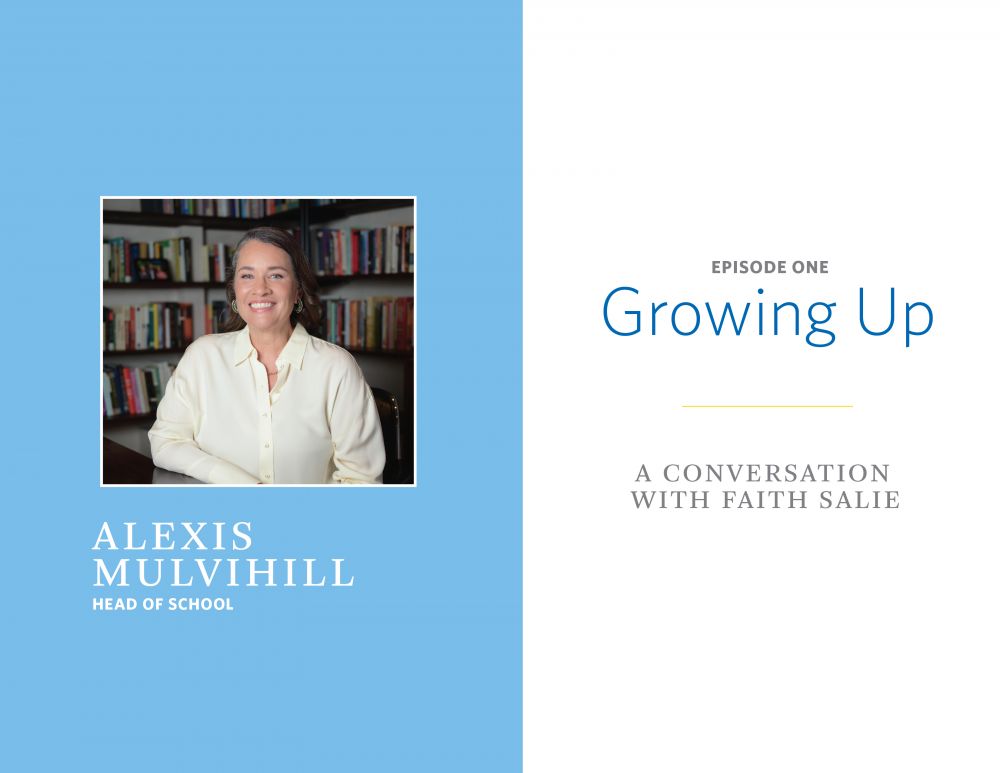

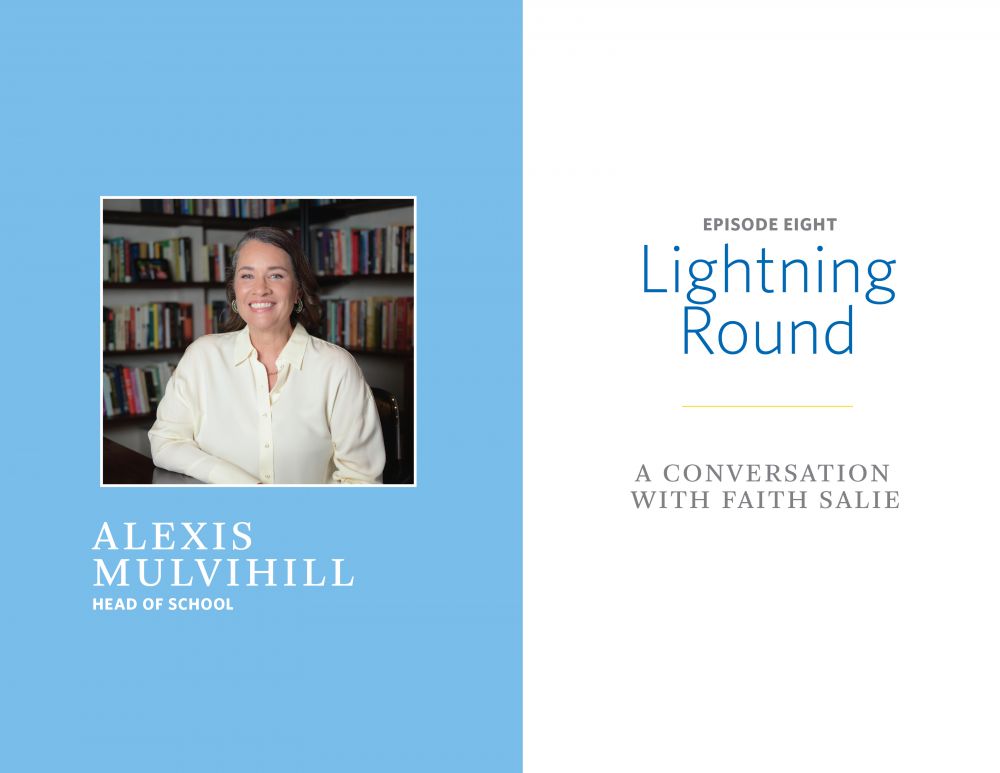
Alexis Mulvihill and Faith Salie: A Conversation | Episode...
Alexis Mulvihill and Faith Salie
A Conversation
Episode Eight – Lightning Round
In the final conversation of the series, Faith engages Alexis in a "lightning round" of questions to help the Trinity community get to know who she is in addition to being head of school. They discuss a variety of delightful and engaging topics, including Alexis’s favorite music; the best joke she tells; words of wisdom for students, teachers, and parents; and valuable lessons she has learned from her students.
Trinity’s thirtieth Head of School Alexis Mulvihill talks with Faith Salie, the Emmy-winning contributor to CBS News Sunday Morning and a regular panelist on NPR’s Wait Wait…Don’t Tell Me! Faith is also the parent of a student in fifth grade.
Alexis and Faith met in Trinity’s Lower School Library to talk about Alexis’s childhood, her education, Trinity, her hopes and plans for the future…and countless other topics. In an expansive conversation to be released over multiple episodes, Alexis and Faith explore the essential questions about K-12 education today and how Trinity continues to do an exemplary job of preparing students for the future.

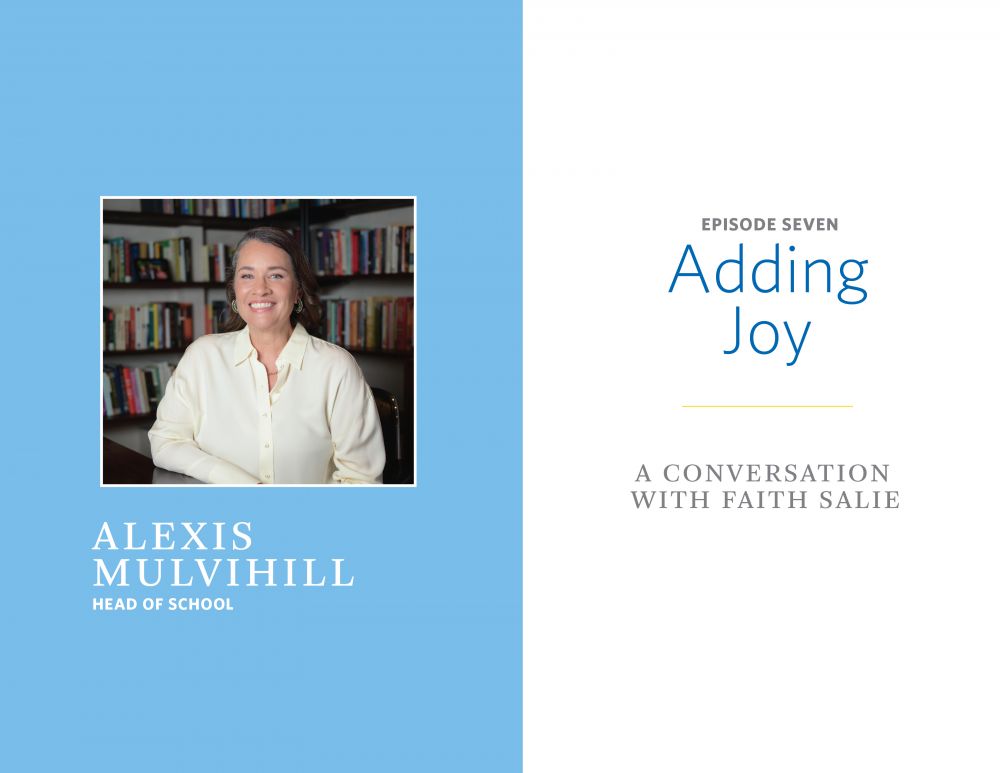
Alexis Mulvihill and Faith Salie: A Conversation | Episode...
Alexis Mulvihill and Faith Salie
A Conversation
Episode Seven – Adding Joy
"I think there’s a way for us to do this, to do Trinity with more joy…There’s an alchemy here of joy, intellect, heart, mind, and conversation that I just have never experienced anyplace else."
In episode seven, Alexis and Faith talk about the ways in which students experience joy at Trinity and how to help students sustain joy as the feeling of academic pressure increases. Alexis also shares a story about a joyful encounter she had over the summer that exemplifies the joy she hopes students can have in all aspects of their lives at Trinity.
Trinity’s thirtieth Head of School Alexis Mulvihill talks with Faith Salie, the Emmy-winning contributor to CBS News Sunday Morning and a regular panelist on NPR’s Wait Wait…Don’t Tell Me! Faith is also the parent of a student in fifth grade.
Alexis and Faith met in Trinity’s Lower School Library to talk about Alexis’s childhood, her education, Trinity, her hopes and plans for the future…and countless other topics. In an expansive conversation to be released over multiple episodes, Alexis and Faith explore the essential questions about K-12 education today and how Trinity continues to do an exemplary job of preparing students for the future.

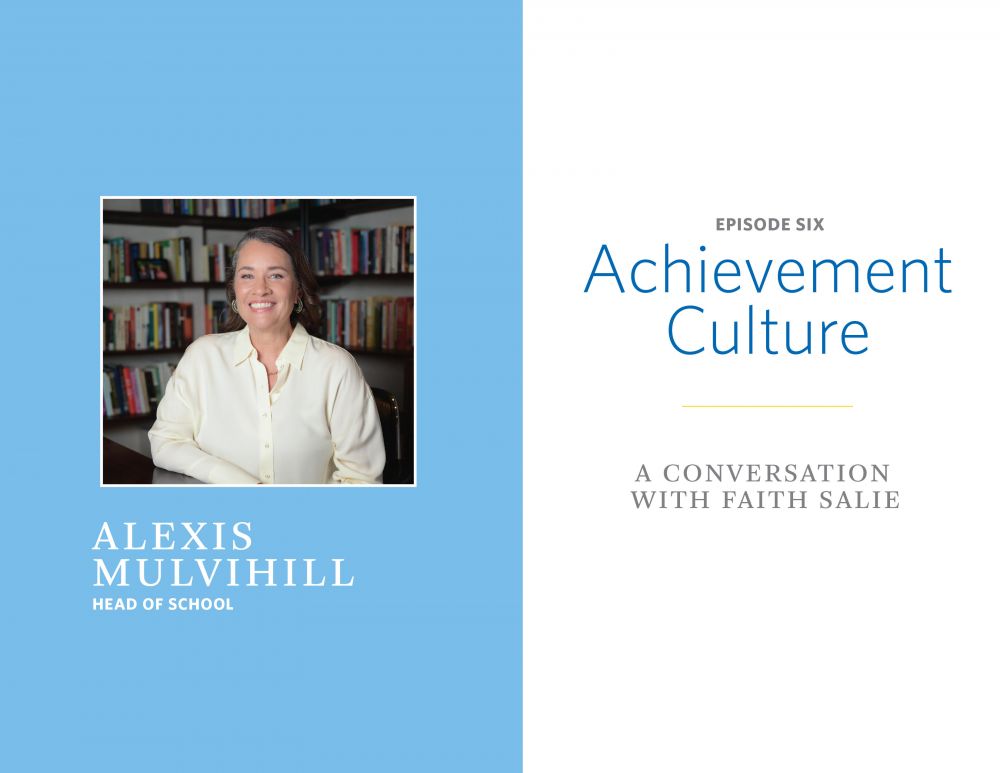
Alexis Mulvihill and Faith Salie: A Conversation | Episode...
Alexis Mulvihill and Faith Salie
A Conversation
Episode Six – Achievement Culture
“What we can do is try to make 'Hamlet' as beautiful as we possibly can...to draw them into the music so they can experience it, hear it, and feel it.”
In episode six, Alexis and Faith discuss how expectations for perfection are set for students and how important it is to push back against those expectations, especially when the college process appears to reward such flawless high achievers. They talk about achievement culture and how it is at odds with taking risks and learning and the other essential elements of growing up.
Trinity’s thirtieth Head of School Alexis Mulvihill in conversation with Faith Salie, the Emmy-winning contributor to CBS News Sunday Morning and a regular panelist on NPR’s Wait Wait…Don’t Tell Me! Faith is also the parent of a student in fifth grade.
Alexis and Faith met in Trinity’s Lower School Library to talk about Alexis’s childhood, her education, Trinity, her hopes and plans for the future…and countless other topics. In an expansive conversation to be released over multiple episodes, Alexis and Faith explore the essential questions about K-12 education today and how Trinity continues to do an exemplary job of preparing students for the future.

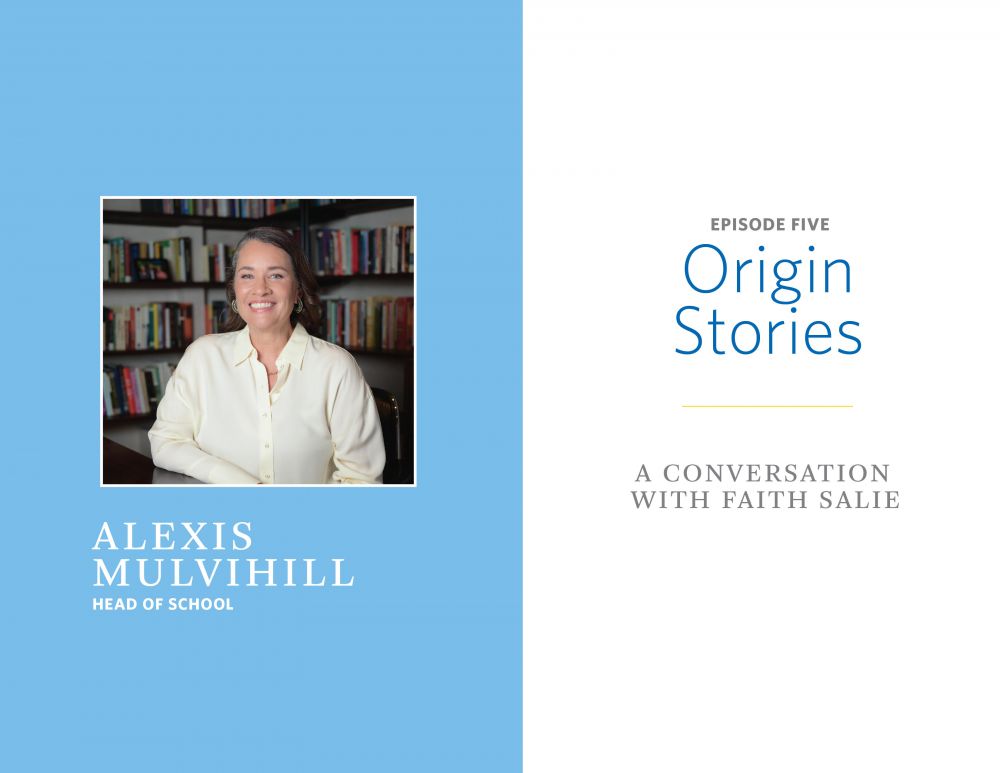
Alexis Mulvihill and Faith Salie: A Conversation | Episode...
Alexis Mulvihill and Faith Salie
A Conversation
Episode Five – Origin Stories
“The more a child understands themselves as part of a lineage…the more rooted they feel in the world.”
In episode five, Alexis and Faith engage in a fascinating conversation about the importance of lineage and Trinity’s origins as a Charity School. They discuss significant aspects of the Trinity experience, including the Chapel program and Office of Public Service, and how Trinity inspires students to learn about themselves, their community, and the world.
Trinity’s thirtieth Head of School Alexis Mulvihill talks with Faith Salie, the Emmy-winning contributor to CBS News Sunday Morning and a regular panelist on NPR’s Wait Wait…Don’t Tell Me! Faith is also the parent of a student in fifth grade.
Alexis and Faith met in Trinity’s Lower School Library to talk about Alexis’s childhood, her education, Trinity, her hopes and plans for the future…and countless other topics. In an expansive conversation to be released over multiple episodes, Alexis and Faith explore the essential questions about K-12 education today and how Trinity continues to do an exemplary job of preparing students for the future.

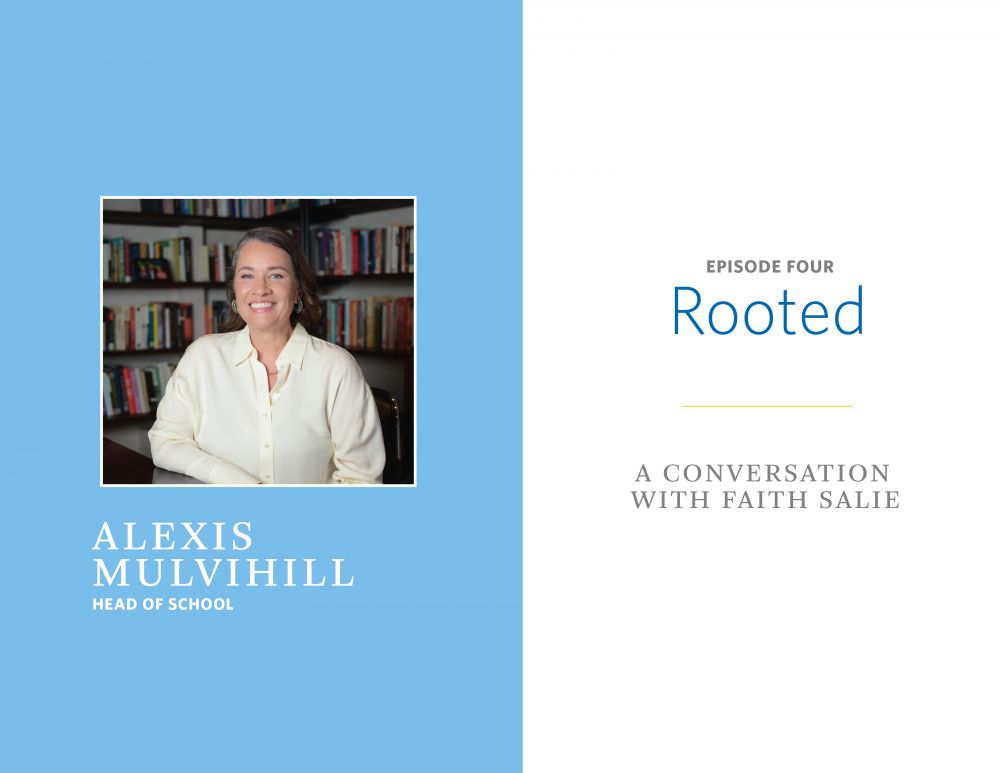
Alexis Mulvihill and Faith Salie: A Conversation | Episode...
Alexis Mulvihill and Faith Salie
A Conversation
Episode Four – Rooted
“This is a school that has profoundly deep roots. It’s been in this city for 300 years…I’m so drawn to the idea of a school that knows itself.”
In episode four, Alexis and Faith explore this year’s Chapel theme, “Rooted,” and its connection to Trinity. They discuss two powerful truths that arise from Trinity’s motto, Labore et Virtute, and the ways in which Trinity depends on a deep root system that has been growing for generations. Alexis also shares one of her first experiences at Trinity—a story about a tree.
Trinity’s thirtieth Head of School Alexis Mulvihill in conversation with Faith Salie, the Emmy-winning contributor to CBS News Sunday Morning and a regular panelist on NPR’s Wait Wait…Don’t Tell Me! Faith is also the parent of a student in fifth grade.
Alexis and Faith met in Trinity’s Lower School Library to talk about Alexis’s childhood, her education, Trinity, her hopes and plans for the future…and countless other topics. In an expansive conversation to be released over multiple episodes, Alexis and Faith explore the essential questions about K-12 education today and how Trinity continues to do an exemplary job of preparing students for the future.

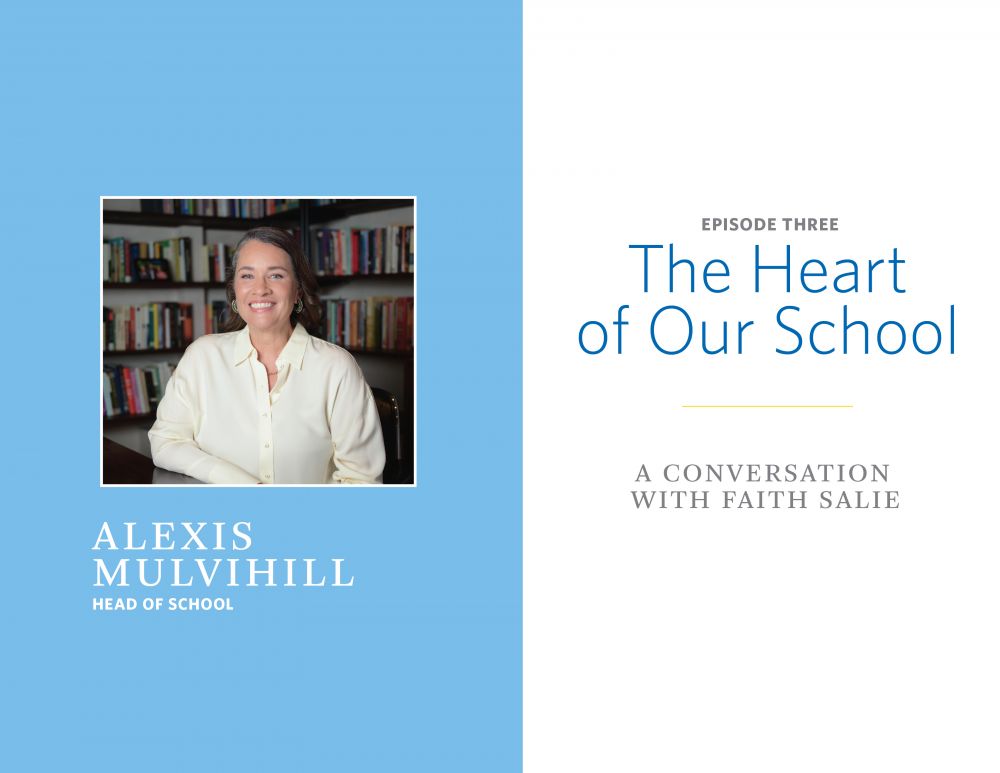
Alexis Mulvihill and Faith Salie: A Conversation | Episode...

Alexis Mulvihill and Faith Salie
A Conversation
Episode Three – The Heart of Our School
In this episode of the conversation with Alexis and Faith they talk about the first sentence in "Our Idea of Excellence," “The conversation between student and teacher is the heart of our school; all that we do must be born of and nourish that relationship.” They explore the importance of conversations about great works of literature (Hamlet, Beloved, Crime and Punishment, Catcher in the Rye, and the Odyssey), and Alexis’s plan to continue conversations with each senior class.
Trinity’s thirtieth Head of School Alexis Mulvihill in conversation with Faith Salie, the Emmy-winning contributor to CBS News "Sunday Morning" and a regular panelist on NPR’s "Wait Wait…Don’t Tell Me!" Faith is also the parent of a student in fifth grade.
Alexis and Faith met in Trinity’s Lower School Library to talk about Alexis’s childhood, her education, Trinity, her hopes and plans for the future…and countless other topics. In an expansive conversation to be released over multiple episodes, Alexis and Faith explore the essential questions about K-12 education today and how Trinity continues to do an exemplary job of preparing students for the future.

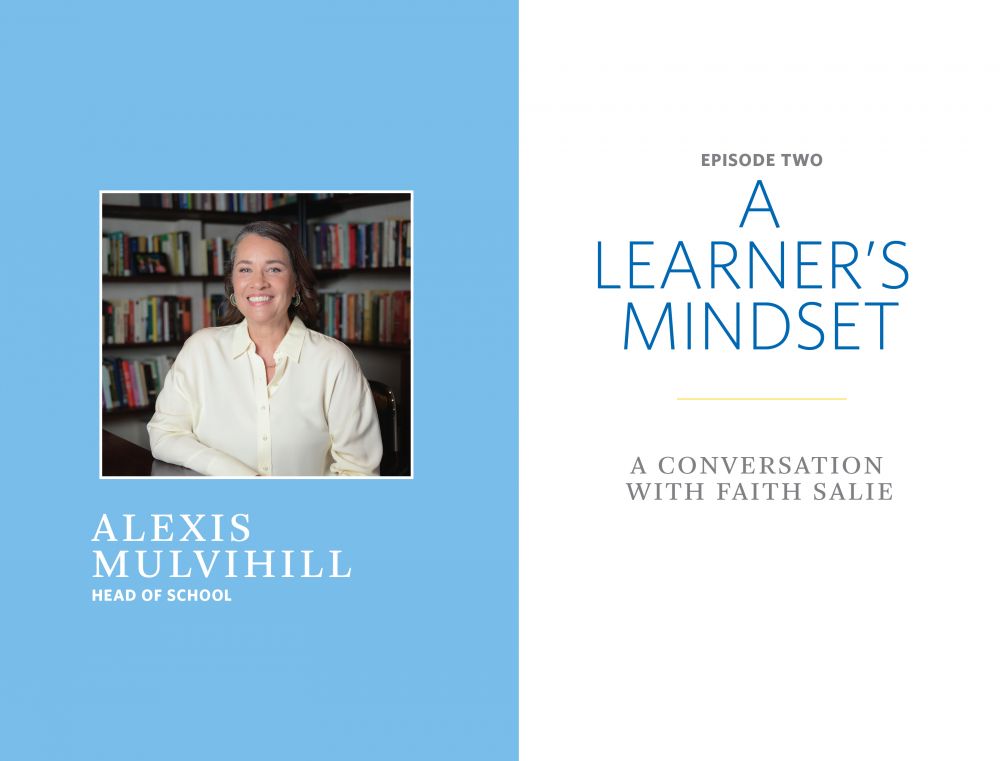
Alexis Mulvihill and Faith Salie: A Conversation | Episode...
Alexis Mulvihill and Faith Salie
A Conversation
Episode Two – A Learner's Mindset
Trinity’s thirtieth Head of School Alexis Mulvihill in conversation with Faith Salie, the Emmy-winning contributor to CBS News Sunday Morning and a regular panelist on NPR’s Wait Wait…Don’t Tell Me! Faith is also the parent of a student in fifth grade.
Alexis and Faith met in Trinity’s Lower School Library to talk about Alexis’s childhood, her education, Trinity, her hopes and plans for the future…and countless other topics. In an expansive conversation to be released over multiple episodes, Alexis and Faith explore the essential questions about K-12 education today and how Trinity continues to do an exemplary job of preparing students for the future.


Alexis Mulvihill and Faith Salie: A Conversation | Episode...
Alexis Mulvihill and Faith Salie
A Conversation
Episode One – Growing Up
Trinity’s thirtieth Head of School Alexis Mulvihill talks with Faith Salie, the Emmy-winning contributor to CBS News Sunday Morning and a regular panelist on NPR’s Wait Wait…Don’t Tell Me! Faith is also the parent of a student in fifth grade.
Alexis and Faith met in Trinity’s Lower School Library to talk about Alexis’s childhood, her education, Trinity, her hopes and plans for the future…and countless other topics. In an expansive conversation to be released over multiple episodes, Alexis and Faith explore the essential questions about K-12 education today and how Trinity continues to do an exemplary job of preparing students for the future.

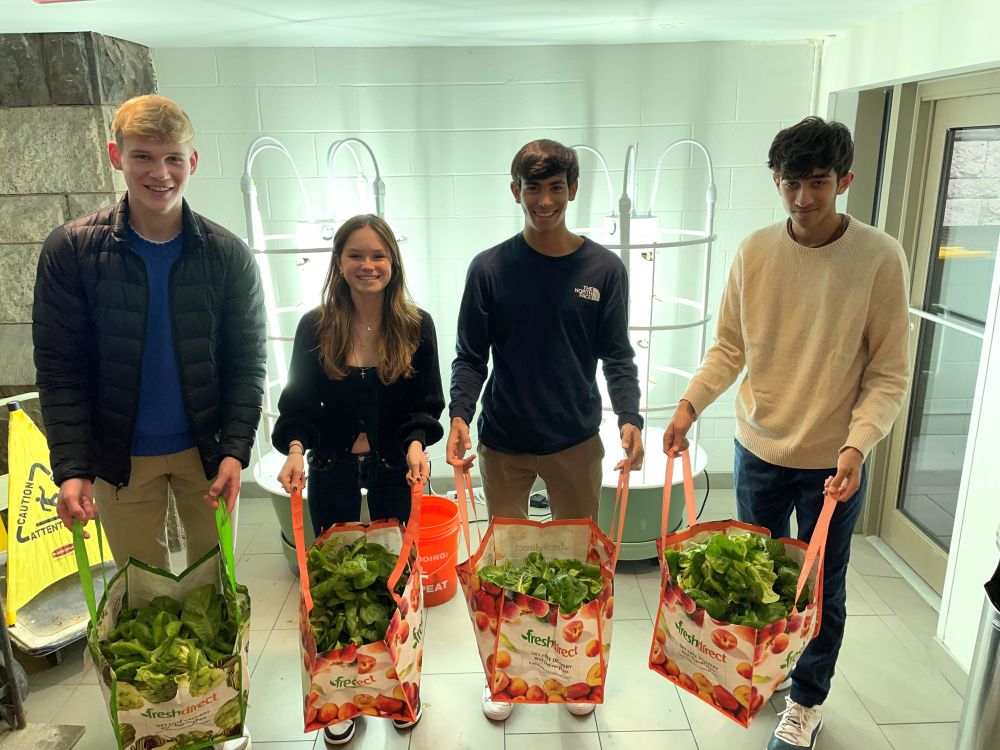
Trinity’s Green Team harvests lettuce and donations are de...
This week Trinity's Upper School public service group the Green Team harvested over thirty heads of romaine lettuce from the hydroponic tower gardens on campus. The Middle School Service Council bagged the individual heads of lettuce, General Manager of Flik Dining Services Paul Kulig kindly stored the bags overnight, and Upper School students and parent volunteers delivered the individually bagged lettuce with Trinity's weekly food donations to the DeHostos Community Center. "Fresh produce like this is such a luxury, so we are especially grateful to the Upper School Student Senate and the Office of Operations and Auxiliary Services for making this possible!" said Director of Public Service Kim Vinnakota ’98. The Green Team petitioned the Upper School Student Senate and the Office of Operations and Auxiliary Services to purchase the hydroponic tower gardens during the 2021-2022 academic year and installed them in the alcove off the Long Hall near the Dining Room and Berlind Garden. Since then, the Green Team has been responsible for planting and caring for the tower gardens. There was a setback in the autumn when the students discovered that some grow lights were broken. Fortunately, they figured out how to fix them and resolved the issue. The Green Team is Trinity's largest public service group with four leaders who helm four separate committees. This is their first harvest and the next harvest is expected in three to four weeks.

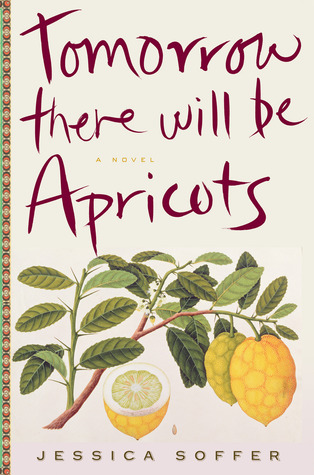
Author Profile – Jessica Soffer ’03

John Hanly, Former Faculty Member, Upper School Principal, a...

One of the giants of Trinity’s history, John Hanly, has died, following a long illness, at the age of seventy-eight.
John Hanly was a native of Cardiff, in Wales, and was educated at Oxford. He taught for several years in Britain before coming to the United States and joining Trinity in 1968. At Trinity, Hanly was a member of the English Department, a “form master” in the parlance of the day, coordinator of student volunteer programs, and a soccer coach. From 1973 until 1975, he was principal of the Middle School. In 1975, he became assistant headmaster and principal of the Upper School, positions he held until 1986. He served as interim headmaster at Trinity during the 1986-1987 school year before commencing a thirteen year career as head of the Pingry School, from which he retired in 2000. Throughout his administrative career at Trinity, he continued to teach English at Trinity as well as at Project Broad Jump and then at Prep for Prep on the weekends and in the summer.
John Hanly was known as the consummate Trinity teacher whose love of literature and language was matched by his love of his students and his devotion to Trinity. In return, he was beloved by generations of Trinity students and colleagues with whom he maintained lifelong relationships as a mentor and dear friend, relationships that lasted to the very end of his life. In 2016, a group of his former Trinity students came together to name the John Hanly Upper School Offices and Conference Room, “In Honor of Our Teacher, Mentor and Friend: Given by his former students, with gratitude for his many years of service and his impact on generations of alumni and faculty with his brilliant mind, lively conversation, and gentle wit.”
In the coming days, a fuller remembrance of Hanly’s service at Trinity and of his profound impact on scores of Trinity alumni and colleagues will be mounted on the Trinity Web site. To share memories and stories of him, please email [email protected].
As we mourn John Hanly’s passing, let us remember most his love of teaching and learning, his dedication to Trinity, and his care for his students and his colleagues. May he rest peacefully.

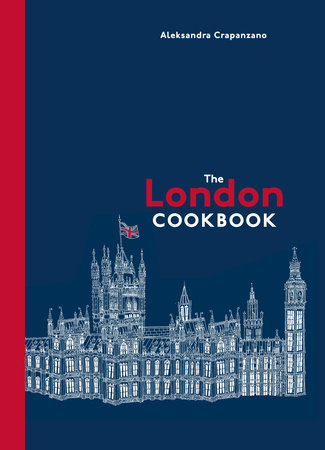
Author Profile – Aleksandra Crapanzano ’88
Aleksandra Crapanzano ’88, author of The London Cookbook: Recipes from the Restaurants, Cafes, and Hole-in-the-Wall Gems of a Modern City and EAT. COOK. L.A.: Recipes from the City of Angels, talks about her love of cooking and her interest in the cuisine of England.
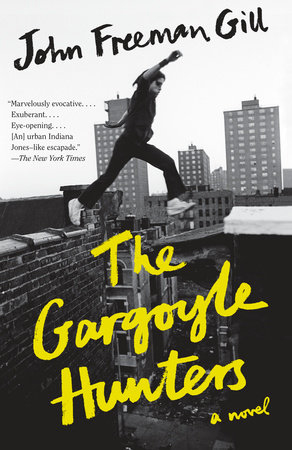
Author Profile – John Freeman Gill ’84
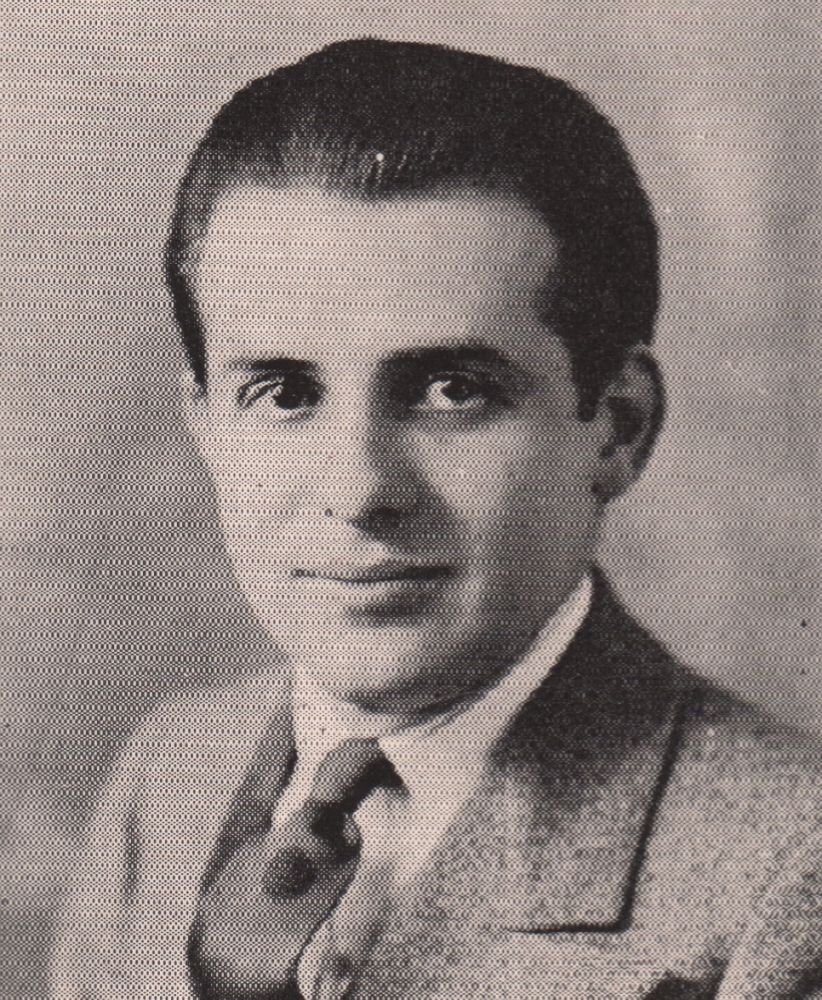
Monsieur Bolduc
Monsieur Bolduc
by Francis J. Sypher Jr. ’59
Engagement is the theme of this issue of Trinity Per Saecula and for this discussion it can be applied in two senses, English and French, related, but distinct. In English the word implies taking something on—like a challenge—and coming to terms with it. The French word engagement carries an overt political sense, suggesting commitment to a cause and a willingness to take action on its behalf. With Monsieur Paul Bolduc, who taught French at Trinity from the fall of 1946 until his death in June 1978, one could say that both apply. He was truly engagé in his profession as a teacher; and he was constantly engaging himself and his students in challenging activities where, by working together, they could achieve success, however defined.
Paul Philippe Bolduc was born in Worcester, Massachusetts, on 3 August 1911, the first of five children of Philippe H. Bolduc and Albertine Martin. The elder Bolduc was born in Canada in February 1884 and naturalized as an American citizen in 1893. As of the 1910 census, he lived at 2 Wall Street in Worcester, where he was proprietor of a grocery store. He and Albertine, also originally from Canada, were married in Montreal in 1910.
Paul’s younger brother, Robert, became a prominent surgeon in Worcester, Massachusetts (b. 14 August 1913; d. 16 November 2009). They had three sisters: Gertrude B. Jacques (1912–1989); Lucile B. Brault (1916–1984); and Pierrette B. Bourke (1919–2008).
As of the 1920 census, Paul, age eight, was living with his family at 7 Chrome Street in Worcester, and in April 1930, age eighteen, at the same address and working as a grocery store clerk, presumably in his father’s store.
He entered the State Teachers College at Fitchburg, Massachusetts (north of Worcester, near the New Hampshire border), now Fitchburg State University, in the fall of 1930, graduating in 1933 with a Bachelor of Science in education degree. His write-up in Saxifrage, the college yearbook, shows him to have been one of the outstanding students in his large class, with special praise for his “splendid piano playing” which was “always attended with rapt attention.” More importantly, he was characterized as “one of those people who are never satisfied until they have reached as near perfection as it is humanly possible.” He is praised for his “excellent work” as a “real teacher” in his student teaching at a local elementary school. In sum, he had “the well-deserved reputation of being one of the most persevering and ambitious students in the college.” His list of extracurricular activities includes: president of the glee club, member of the art club, member of the geography club, and serving on the board of the yearbook. Clearly his capacity for creative and successful engagement with his profession developed early and was in full swing during his college years.
As of April 1935, Bolduc was living in Paris, France. Apparently it was during this period that he studied at the Sorbonne and earned the diplôme supérieur, his French degree in education. In Paris he also studied at the Alliance Française, which offered courses for teachers of French. He sailed to the United States on the Compagnie Générale Transatlantique’s glamorous and luxurious SS Île de France from Le Havre on 10 July arriving in New York on 16 July 1935. It is not clear whether this was his definitive return to the United States, or one of several voyages back and forth.
In the fall of 1937 he began teaching French at New Hampton School, a private secondary school founded in 1821. At this period, he also began study during summer sessions at the French Language School of Middlebury College, which he attended in 1938, 1939, and 1940, when he was awarded on 12 August a Master of Arts in French.
In the fall of 1940, now with an MA degree, he became head of the French department at New Hampton, and in June 1941 the senior class dedicated the school yearbook, the Belfry, to him “with respect and appreciation.” He later was teaching English as well as French.
Paul Bolduc enlisted in the US Army on 20 June 1942, and during 1944 was on leave from school for military service; he was released from service 10 November 1945. I regret that I have found no details about the exact conditions of his army service. Upon his return to New Hampton School in 1945, he was director of music, English, and French, and as pianist directed the glee club. His last year at the school was 1945–1946.
The story I heard from Clarence Bruner-Smith about Monsieur Bolduc’s first arrival in New York to teach at Trinity in the fall of 1946 was that Harold Ballentine, a Lower School math teacher, had offered to rent Bolduc a room in his apartment, which he accepted. Ballentine was a rather bluff personality who from the mid-1950s headed the Lower School after the retirement of John Langford.
One day Bolduc, in conversation with Matthew E. Dann, the headmaster at that time, happened to mention (probably not by accident) the amount of rent he was paying for the room, and Dann thought it sounded high, so he contacted the landlord of Ballentine’s building and asked what rent Ballentine was paying for the apartment. It turned out that Ballentine was charging Bolduc the full amount of the rent for the whole apartment. Dann immediately got in touch with Ballentine, worked out a settlement, and arranged for Bolduc to reside in the former St. Agnes vicarage, which, with the parish house (Trinity’s Annex), had been spared when the main building of St. Agnes Chapel was demolished in 1944. Trinity School then used the large townhouse as a residence for boarding students and faculty members.
The apartment market in New York became extremely tight after the troops came home in 1945; and for a new teacher on a modest salary, it was difficult to find housing in the city. So for Trinity to offer living accommodations was much appreciated. In later years, after the boarding program had ended, the vicarage was entirely devoted to faculty housing and was known as the Residence. Many curious stories arose about life there. Frank G. Smith, who taught Latin at Trinity, was convinced that the place was haunted by the restless spirit of a past vicar of St. Agnes. He swore that windows and doors would open and close, and lights would go on and off by themselves when he was quite alone in the house, where he lived upon first arriving at Trinity in 1951. The Residence was torn down in 1955 to make way for a new gymnasium, now also long gone.
The memoirs of Bill Goralski ’48 present two fine vignettes of Monsieur Bolduc during this period. Goralski, a superb athlete, entered Trinity in the fall of 1946 as a scholarship student in the special boarding program initiated by Dann after the acquisition of the St. Agnes Chapel property. Goralski describes how on his first day of classes with Bolduc in 1946 he was in the 139 West 91st Street building, where most classes were then held, and gazing out the window of the French classroom at the surrounding rooftops and at the large tan brick structure of Joan of Arc School across the way on 92d Street, when he was suddenly “jolted” “by a shrill, peppy voice that said, ‘Bonjour. Comment allez-vous?’” And with that, Monsieur Bolduc “bounced into the room and said, ‘Asseyez-vous, s’il vous plaît.’”
Dressed in a conspicuously unconservative “suit, pink shirt, and vertical striped tie”—a hep 1940s style—with “an abundance of black, wavy hair” and “riotous in his sense of humor,” Bolduc “went immediately into rapid-fire French” and then in English yelled at one of the students: “Wake up, Mr. Wolf. Where the hell do you think you are? On summer vacation?”
Goralski then recounts an incident that beautifully brings out Bolduc’s sensitivity in contrast with his sometimes rambunctious classroom manner. Goralski, a Roman Catholic, one day found himself in chapel when communion was going to be celebrated according to the rites of the Protestant Episcopal Church. As a new student on a highly prized scholarship, he felt that he had to go along with things at Trinity as much as possible, and so he went up to the altar and received communion, although with considerable reluctance, and then felt guilty about it. Later he was in French class, where he was “quiet” and not his “usual self,” as Bolduc noticed. Goralski recounts the sequel:
I remembered what Monsieur Bolduc had told us about France in his introduction to studying the French language. He mentioned that most of the French people were Catholic, except for the Huguenots, and since he told us that he came from a French family in Worcester, Massachusetts, perhaps he was Catholic.
After class I stayed behind for a minute when the others left and asked my French teacher, “Are you Catholic?”
“Oui, Guillaume. Pourquoi?”
I said, “Please speak to me in English. I have a problem.” I told him about communion.
“Oh, mon Dieu,” he said. “Don’t worry about it. You have done nothing wrong.”
“Is there a Catholic church around here?” I asked.
“There’s a small church right around the corner on 90th Street. Do you want to go there with me on Sunday?”
“Yes, thank you,” I said gratefully.
The place was the Church of St. Gregory the Great, in its impressive school building at 144 West 90th Street. Goralski went there for confession on the following Saturday afternoon, and on Sunday morning Bolduc knocked on his door in the Residence and together they attended Mass at St. Gregory’s.
To conclude the story, Goralski remarks that afterward, whenever communion was celebrated in the Trinity School chapel, he “sat in the back of the chapel with Monsieur Bolduc.”[1]
Here is a different kind of engagement—with the personal needs and feelings of one of the students. All through the years Bolduc did countless good deeds of this kind to help students find their way, so that for many of us, as for Goralski, he became a deeply valued friend as well as an inspiring teacher.
June of 1948, when Goralski graduated, saw the conclusion of my first year at Trinity, as a first-grader. I did not know Goralski then, but I was very struck by the frontispiece photo of him in the 1948 yearbook, with Dann presenting him an award. He went on to have an impressive career as a student and star athlete at Trinity College, in Hartford, Connecticut, and then as a successful high-school teacher, in spite of a devastating football injury that occurred in his senior year and left him with extensive paralysis. His drive as a student and athlete helped him to engage with his challenging situation and pursue a fruitful professional life. Years later I was fortunate to get to know him through correspondence and attendance at school alumni events. He always retained a special fondness for Monsieur Bolduc. Goralski died on 16 December 2014, at age eighty-five, near Avon, Connecticut, where he had lived for virtually all of his life.
Upon entering Trinity, I began the study of French in first grade with Susan B. Scott. For some reason French immediately became my favorite subject, and I could never get enough of it. During grade school I heard about Bolduc as an excellent French teacher, and I looked forward very much to being in his class. In the fall of 1956, at the beginning of my second year in the Upper School at Trinity, he was my home room teacher and I studied French with him that year and every year afterward until graduation in June of 1959.
One of the most striking things about Bolduc was the incredible amount of energy that radiated from his presence, in spite of his moderate stature. The influence of his colorful personality and wide-ranging talents were everywhere perceptible at Trinity School. Just as Bill Goralski described it in 1946, so also in 1956 and after, from the moment a class began Monsieur would be talking—almost always in French—walking back and forth, writing on the blackboard, calling on students, doing everything to engage our attention and keep us on the alert.
Necessarily a lot of our classwork involved vocabulary and grammar, but Bolduc made exercises and readings come alive by using details in the texts as occasions for interesting, often amusing, discussions of French culture.
Among the books we used was A French Vocabulary, published by the Independent Schools Education Board (formerly the Secondary Education Board) (Milton, Massachusetts, 1948; revised and corrected edition, 1952). With 202 pages and approximately 7,000 words, it was arranged in numerous subject categories (such as les repas—“meals”—or les vêtements—“clothing”) and in a general alphabetical list. We often had to flex our memories to learn a substantial number of words at a time. In addition, come November, Monsieur Bolduc would distribute a mimeographed vocabulary list of his own titled Le jour d’action de grâces—literally “the day of giving thanks,” i.e. Thanksgiving Day—with dozens of words relating to seasonal food and food service. It was a long list, and it took a good deal of effort to learn and remember the words because many of them were totally unfamiliar. The last item was not so hard: avoir une indigestion aiguë (“to have acute indigestion”). In later years I was glad to have studied this list because cuisine was a recurrent topic in French contexts.
In French grammar, Monsieur had a number of mnemonic devices that he would use to engage our memory. For example, there was the CEPS rule: croire, espérer, penser, and savoir (“believe,” “hope,” “think,” and “know”) are followed by the indicative mood in affirmative statements and by the subjunctive mood in negative and interrogative statements.
To help recall certain irregular plurals, we had the “sexy seven”: bijou, caillou, chou, genou, hibou, joujou, and pou (“jewel,” “pebble,” “cabbage,” “knee,” “owl,” “toy,” and “louse”) take -x in the plural (x makes them “sexy”).
There were the “filthy five”: beau, nouveau, fou, mou, vieux (“beautiful,” “new,” “mad,” “soft,” “old”) become bel, nouvel, fol, mol, and vieil in the masculine form before a vowel or an aspirated h.
And we were introduced to that marvelous trio, beloved of grammarians: amour, délice, and orgue (“love,” “delight,” and “organ”), nouns that are masculine in the singular but feminine in the plural.
We had to memorize a certain amount of French poetry, which Bolduc would urge us to recite with literary and dramatic expression as well as accurate pronunciation. Among the poems we learned were: “La Cigale et la fourmi” by Jean de la Fontaine; from Romances sans paroles, “Il pleure dans mon coeur” by Paul Verlaine; and the great romantic meditation “Le Lac” by Alphonse de Lamartine, in which the poet laments the inexorable passing of time.
Some of the French books we read in Bolduc’s class were: Colomba (1840) by Prosper Mérimée, an exciting story set on the Island of Corsica; Pêcheur d’Islande (1886) by Pierre Loti about fishermen from Brittany; and Symphonie pastorale (1919) by André Gide, a story of a French Protestant family. The somewhat antique texts were excellent vehicles for becoming acquainted with literary French. As supplementary material, I also read, among other works, Voltaire’s philosophical fable Candide (1759), interest in which was stimulated by the Broadway production of Leonard Bernstein’s operetta Candide in 1956.
We read a number of short stories in an anthology titled Contes et nouvelles du temps présent, edited by M.E. Coindreau and J.R. Loy (1941). In this collection I was especially struck by Colette’s haunting story “Au Milieu des ruines.” In 1958 such readings did not exactly seem like temps présent to us, but there was an inevitable time lag in all our textbooks.
For example, our New French Review Grammar (1935), a revision by A.G. Bovée of a book published in 1920 by D.H. Carnahan, offered illustrated readings based on the visit of a semi-fictional journalist (i.e., Bovée) to Paris in the 1930s. There was mention of the great French comédien Bénoît-Constant Coquelin and his creation in 1897 of the title role in Rostand’s Cyrano de Bergerac. Coquelin had died in 1909, but the memory of his appearance in one of his great roles, which also played in New York in 1900 with Sarah Bernhardt as Roxanne, was in 1958 still being praised in Bolduc’s classroom, via this textbook as an ultimate experience of French drama—and why not? Great cultural achievements are timeless. I had recently admired José Ferrer in the movie version of Cyrano (1950), and when I visited Paris for the first time in 1963, my memory of Bolduc’s class helped inspire me to see at the Théâtre du Châtelet a marvelous production of Rostand’s L’Aiglon, but not, alas, with la divine Sarah.
Another chapter in the same grammar book contained a reading about visiting les Halles Centrales. When we went over the passages in the book, Bolduc told us in detail about les Halles (avec un h aspiré, s’il vous plaît), the central produce market, and when I went there in 1963, I found that little had changed. Farmers from all over the surrounding area drove into the center of Paris during the very early hours of the morning to deliver their products; and grocers, restauranteurs, and hoteliers came to buy supplies. It was a chaotic, colorful, all-night spectacle that the visitor would traditionally top off around 5:00 or 6:00 in the morning with a big bowl of soupe à l’oignon—a French farmer’s typical breakfast dish—at one of the nearby busy restaurants where everything served was the freshest possible. However, since 1977, when the vast structure of the Centre Pompidou was built and opened on the site, the old Halles are no more.
Among his many talents, Bolduc, as mentioned in his college yearbook, was an excellent pianist, and for Trinity School assemblies he would occasionally organize musical and dramatic presentations in which a class would sing French songs and perhaps perform a short comic skit in French. He arranged the piano accompaniment for a comic melodrama produced and performed by Trinity faculty members in March 1959, Love Rides the Rails (or Will the Mail-Train Run Tonight?) (1940) by Morland Cary (pseudonym of Hugh Nevill).
Bolduc’s sense of humor was apparent one evening in the fall of 1958 when he attended a school Halloween dance held in St. Agnes Hall, on the top floor of the Annex. This magnificent space had great wooden beams and braces supporting the steep roof, and at the east end was a stage where many fine theatrical productions were presented. St. Agnes Hall was perhaps my favorite architectural space in the whole school because there was something mysterious and slightly spooky about it. The effect was enhanced by a fascinating painting filling a lunette above the stage that showed a somewhat bizarre assortment of storybook characters around a large black cauldron; among them I especially remember a very tall, very thin personage at the side, with a somewhat pensive smile on his face. St. Agnes Hall was the perfect setting for a Halloween party. I attended with a student from Nightingale-Bamford, class of 1960, and we did not have special costumes on, but at least two of the teachers who attended wore impressive ones.
Smith, the Upper School Latin teacher, came as a sorcerer and wore a costume somewhat recalling the figure in the Sorcerer’s Apprentice in the animated movie Fantasia (1940), only far more splendid. He wore a long-sleeved dark blue academic gown, with appliquéd golden crescent moons and stars all over it, and a matching tall conical hat, and he carried a magic wand. He looked as if he could have effected any kind of transformation with ease. Perhaps one might say that in order to make Latinists of such uncouth material as most of us were, he must indeed have been something of a wizard.
Monsieur came attired as the perfect image of a Parisian denizen of la bohème or bohemia as we imagine it from Murger’s novel, or Puccini’s opera, in a turtleneck shirt, and a beret titled at a rakish angle. He had smeared a bit of burnt cork on his face, and held an unlit cigarette as a prop. He seemed to have stepped right out of some vaguely disreputable café on the Left Bank, and was enjoying every minute of the party, with his high spirits in full play.
Perhaps his costume was partly inspired by his sense of his low salary, which he used to joke was “17¢ a day.” But in the 1950s he took winter or spring vacations at Round Hill, a posh resort hotel in Jamaica (visits financed perhaps by his brother Robert), and traveled to France in the summer.
From time to time Bolduc arranged for us to visit the Alliance Française in New York (now merged with the French Institute as FIAF) to see French movies, and also told us about ones that we might be interested in seeing at regular movie theaters like the Paris on 58th Street, just west of Fifth Avenue. But when I mentioned to him that I was going to see the noir thriller Diabolique (1955), with Simone Signoret, he exclaimed, not quite seriously, “Vous êtes trop jeune pour ça!” (“You’re too young for that!”), which greatly stimulated my interest.
We were always encouraged to attend live dramatic productions by the great French theatrical companies that regularly visited New York in the 1950s, such as the Théâtre National Populaire or TNP, with Jean Louis Barrault, which presented Musset’s Lorenzaccio one year. The Comédie Française presented classics like Molière’s Tartuffe, or a major tragedy by Racine or Corneille. The language in these performances was difficult for us to follow, but with knowledge of the plot and some advance preparation we found the presentation tremendously impressive. I remember how thrilling it was the first time I attended a performance by the Comédie Française and heard the three beats indicating that the play was about to begin.
Bolduc brought into class for us back copies of French newspapers and magazines such as Le Figaro; Le Canard enchaîné; Paris Match; and Réalités, a deluxe glossy magazine with excellent articles and fabulous photography (it ceased publication in 1978). We could look at them in school or take them home with us to read as best we could, and when we came back to him with questions he would be delighted to discuss. The newspapers were especially difficult for us because to understand the articles one needed not only an up-to-date vocabulary of fashionable, often slightly slangy terms and idioms, but also to know a good deal about what was going on at the time in Paris—and in Algeria, which was much in the news in 1958. Monsieur could fill us in on details, since he was always au courant.
From magazines and newspapers and other sources, Bolduc kept a large file of clippings of articles and pictures that he posted on the bulletin board in his classroom. They were always attractive to look at and interesting to read, and he changed them often. He also sometimes posted clever drawings by Togwell Jackson ’57, a brilliant cartoonist with a keen sense of humor who could certainly have made a fine career in that field if he had pursued it.
A typical scene after regular classes ended at 2:30 or 2:40 p.m. was of Monsieur sitting at his desk coaching a student who had come for extra help or for advice on a term paper. Or else when there were no students requiring his attention, he would spruce up his bulletin board or grade papers in red fountain-pen ink. On top of his desk, his briefcase sat stuffed with students’ papers for correction and his striped thermos of hot coffee sat ready nearby so that from time to time he could sip from the red plastic cup that fitted on top.
His classroom was also decorated with posters of French scenes. For example, high on the front wall was an atmospheric view of the streets of Montmartre, showing a boulangerie in the foreground, with the street branching left around it; in the distance, above the rooftops of the old Parisian buildings rose the dome of Sacré Coeur. I looked at this often and wished I could be transported there and wander those streets and sample the products at that bakery, because ever since early childhood I had dreamed of visiting Paris, but so far had never had the opportunity. There was also a poster of Mont St. Michel showing the flats around the island at low tide. And there were posters of the Arc de Triomphe, the Tour Eiffel, and Notre Dame, always looking down at us in the room and reminding us of the attractions of Paris and the glories of French culture.
Bolduc had two bookcases in the room, one of painted open shelves underneath the north window by his desk, and one in exactly opposite position with glass paneled doors. The shelves were stuffed with French books that we could consult or borrow or sometimes keep if we wished—including literary classics from Balzac to Zola, as well as books by then-current writers such as André Malraux, André Maurois, and Henri Troyat. In the bookcase by the window I discovered a copy of the Petit Larousse illustré, which I had never seen before, and which quickly became my dictionary of choice to consult for French words and for information on French people and places.
Occasionally we had to write a long research paper in French on some literary topic, which we would discuss with Monsieur in detail at every stage in the research and writing. For one of these projects I wrote about the 15th-century French poet François Villon, whose works I read in an attractive, lightly modernized edition—Œuvres (Paris: Aux Quais de Paris, 1957)—that I bought when visiting, upon Bolduc’s recommendation, the Paris Book Center at 31 West 46th Street, where they had an immense stock of French books. Bolduc gave me generous amounts of time discussing every aspect of the project.
Another time I wrote a suitably lengthy paper about Proust’s Du Côté de chez Swann. This introduction to À la Recherche du temps perdu was a revelation to me, and once again Bolduc did everything to explain and to help me effect a creative engagement with my somewhat daunting subject. He also referred me to the library at the Service Culturel de l’Ambassade de France, at 972 Fifth Avenue, where I found friendly assistance and helpful research materials about Proust. I felt immensely grateful to Bolduc and appreciative of his sympathy and encouragement. In writing this profile I am in a way pursuing Villon’s question in his poetic refrain “Mais où sont les neiges d’antan?” (“But where are the snows of yesteryear?”), with my own recherche du temps perdu and trying to achieve some sense of le temps retrouvé (“the past recaptured”).
One day in class Monsieur Bolduc was talking about so-called vieilles âmes (“old souls”), people who have a strong feeling for the past, as opposed to jeunes âmes (“young souls”) who are interested mainly in nouveautés (“the latest”). He went around the room presenting each student in the class with an off-the-cuff personal analysis according to this system. He called me a vieille âme because of my interest in history, literature, and the arts. At the time I perhaps did not give it much thought, but looking back I see that he was quite right.
On another day Bolduc asked how many in the class had heard of Albert Camus and almost nobody had. He was appalled, and told us what an important author Camus was and made us feel that our education and cultural level were woefully incomplete if we did not know about such prominent figures on the contemporary scene.
Bolduc always welcomed students to telephone him or to visit him at his attractive apartment on the ground floor at 16 Pomander Walk, a charming enclave between Broadway and West End Avenue, between 94th and 95th Streets. The interior decoration was French modern in feeling, with cheerful, light-colored fabrics, bright lighting, and a good deal of open space in the living room area. On a large set of shelves built against the north wall he had a collection of Lalique crystal and a number of French books in fine leather bindings. Hanging on the west wall by the dining table was a red paisley shawl that I believe had been in his family in some connection. Here and there he also had French prints, and he had a large painting of a nighttime view of the Hudson River and the Manhattan skyline as seen from the George Washington Bridge.
Monsieur was a generous and thoughtful host and his informal conversation—in French or in English—was at least as inspiring as his classroom presentations, although on an entirely different level. He was extremely sympathetic to students’ concerns and would listen and respond with great sensitivity and thoughtfulness, as in the way he helped Bill Goralski. I saw this especially during my last years at Trinity when my parents were often out in the evening. Bolduc, knowing of my situation, a few times kindly invited me to dine with him at his apartment in Pomander Walk, and I have especially fond memories of those visits. At first I felt that I might be intruding and was apologetic about troubling him, but I was touched when he said that there were times when he was lonely in the evening and he welcomed my company.
Monsieur Bolduc also became friends with the families of many of his students and visited them in their homes. His conversation was always entertaining and delightful. After I graduated from Trinity, he and Smith, who lived across the way at 10 Pomander Walk, were frequent guests at my mother’s apartment (my father had died in 1960) as she and I were at their apartments. In the 1960s and 1970s, I also saw Bolduc at Trinity alumni events. All through the years he kept his capacity for boundless energy and youthful high spirits.
Bolduc died on 10 June 1978. He had been attending a Trinity School dance with great enthusiasm, when he sat down for a moment and suddenly had a fatal heart attack. The following 14 September, a memorial service for him was held in the Trinity School Chapel. Speakers were Matt Dann, Frank Smith, and Robin Lester, headmaster at the time. Smith’s eulogy was the major piece, a thoughtful, eloquent appreciation with insightful comments. He brilliantly characterized Monsieur as above all a “dramatic artist” whose all-embracing theme was the greatness of French culture and civilization his primary audience consisted of the many students and friends, all through the years, who were touched by his genius; and his achievement was in the accomplishments, the memory, and the gratitude of all those who were fortunate enough to come into contact with him in a lifelong performance whose extraordinary quality, to the very end, was never diminished.[2]
Certainly Monsieur Bolduc’s teaching and personality were a major formative influence for me. Throughout my years at college and graduate school at Columbia University in the 1960s I took many French courses, including one on Proust, and I have continued to read French literary works and do research with French sources ever since. In the 1980s I lived for a number of years in francophone West Africa—Togo, Sénégal, and Gabon—where I taught English as a second language, English literature, and American studies at various schools and universities. Among qualifications for these assignments, a major factor was my knowledge of French, which was in large part based on Bolduc’s superb teaching during my years in the Upper School at Trinity.
Trinity School was indeed privileged to have Monsieur Bolduc on the staff for so many years. He was truly exemplary in his engagement and engagement as a teacher and as a person.
[1] Bill Goralski, Away from Avon..., for Awhile (Life at Trinity School in New York City, 1946–48) (Avon, CT: self-published, 1990), 17, 25–26 (title with ellipsis and parentheses thus).
[2] See Trinity Alumni News, (fall 1978): 3; also The Trinity Times 47, no. 1 (25 Sept. 1978): 1. While writing this profile for TPS I inquired to Smith’s Oxford College, Oriel, for biographical information about him. The archivist there kindly sent me a scan of a biographical form that Smith had filled out for the College. I was delighted to recognize his handwriting on the form, and I am including here the basic information, because biographical details about Smith’s early years have not, I believe, been published before for Trinity School readers. His full name was Frank George Smith; he was born on 28 July 1921, son of Sydney Smith, of Coventry, Warwickshire, and had attended King Henry VIII School in Coventry. He matriculated at Oriel College in the Michaelmas term of 1940; graduated with a BA in 1943; and took his MA in 1949. His first teaching assignments were at Christ’s Hospital and at Ampleforth College. He came to the United States in 1948 and first taught at Portsmouth Priory School (now Portsmouth Abbey) in Portsmouth, Rhode Island. He joined Trinity in 1951, and retired in 1983. For years afterward he lived in Wellesbourne, Warwickshire, in a beautiful cottage that he had inherited from an aunt. He died on 9 May 1998 in Kenilworth, England.
Note: Thanks to archivists at New Hampton School and at Middlebury College for helpful information; and to Kevin Ramsey for information from the Trinity School archives. Details on the Bolduc family and other biographical data have been drawn from Internet sources. The Fitchburg yearbooks are available online. Also, while writing this about Monsieur Bolduc I saw on the Internet a delightful memoir about Trinity School from 1949 to 1961, by a member of the class of 1961, who also remembers the painting over the stage on the top floor of the Annex; see: memoirsite.com and look for “trinityschoolclassof1961.”

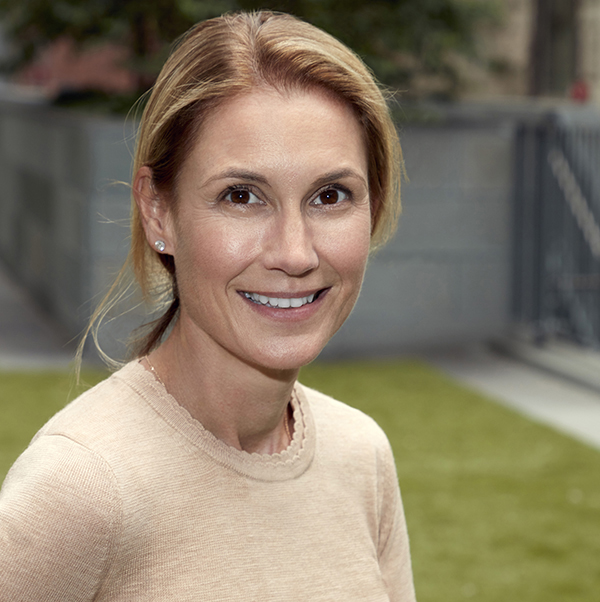
Last Word – Dr. Sarah Bennison
Last Word
Trinity’s director of public service writes about the music between the notes.
By Dr. Sarah Bennison
Favorite Concept: Paul Farmer and Gustavo Gutiérrez’s idea of “accompaniment”
Favorite Poem: “Wild Geese” by Mary Oliver
Favorite Book: Sometimes Brilliant by Larry Brilliant
Favorite Hobby: Reading for pleasure
Favorite Sport: Yoga
Favorite Sports Team: Any team my kids are on
Recently I was listening to a beautiful podcast entitled “Music Happens Between the Notes.” In it, On Being’s Krista Tippett interviews cellist Yo-Yo Ma about his life as a self-described “musical anthropologist.” Seeking to express the vast multiplicity of the human experience, Yo-Yo Ma speaks of the music between the notes. Ma asks, “What, then, do you mean when you say music happens between the notes? Well, how do you get from A to B? Is it a smooth transfer—it’s automatic, it feels easy, you glide into the next note? Or do you have to reach to get to the—you have to physically or mentally or effortfully reach to go from one note to another? Could the next note be part of the first note? Or could the next note be a different universe? Have you just crossed into some amazing boundary, and suddenly the second note is a revelation?”
I was a nine-year-old camper at Interlochen Arts Academy in Northern Michigan when I first heard the cellist Mstislav Rostropovich play in Kresge Auditorium, the crisp Michigan air breezing through the open-air auditorium, the lake glistening in the background. That moment sparked a passion for cello, and I devoted the next ten years of my life to that pursuit, playing throughout the school year in regional and national orchestras and each summer in the woods of Northern Michigan with artists and musicians from all over the world. By the time I was in high school and playing in the World Youth Symphony Orchestra, Interlochen’s top group, I knew that music happens between the notes. Playing in an orchestra, the magic is not just the music; it is the connection that happens when a group of people come together with a shared goal and purpose. It is moments of listening as well as playing, silence as well as noise, seeing as well as feeling, following as well as leading. Music is the result of many notes working together, but the magic happens between the notes in the authentic community of musicians playing together to create something new.
The many notes of the Trinity community beg similar questions with magical possibilities. Our score calls us to think actively about community within and outside of school walls. We ask our students to live fully in our city, to serve our neighbors, and to “give generously and joyfully to others.” Created as a charity school in 1709, Trinity’s founders were explicit in their mission and focus, seeking to create a school to address issues of urban poverty and inequality. Our orchestra is one with a long history and a consistent goal to create a community that values relationships between people: in the conversation between teacher and student, in the connection between school and neighbor, in the friendship between students and colleagues. Our music happens in these relationships, between the notes, and as we make music together, we must ask, as Ma does: “Could the next note be part of the first note? Or the next note be a different universe? Have you just crossed into some amazing boundary, and suddenly the second note is a revelation?”
The key question is how to get from A to B, how to get from one note to the other and to recognize the importance of the space in between. In my role as director of public service, I have sought to create opportunities for Trinity students to grapple with these questions as they engage with our community inside and outside of school in meaningful, regular, and ongoing ways. With a team of faculty from all three divisions, we are shifting traditional paradigms of “community service” that tend toward add-on activities that occur sporadically, seeking to create a thought-leading program unique among schools around the world.
Our work focuses on two guiding principles: regularity of community engagement work and integration into school life. In keeping with Trinity’s focus on the city—on urban poverty and inequality—Trinity’s K-12 public service program is rooted in fourteen neighborhood partners, all within five blocks of School. These “Community Circle” partners provide opportunities for Upper School students to work on a weekly basis within our school community, seamlessly integrating community engagement work as an integral part of school life. On any given day, you will find Trinity students working at Head Start early childhood programs, with seniors at the Goddard Senior Center, with students with autism spectrum disorder at Manhattan Children’s Center, at the West Side Campaign Against Hunger, and assisting teachers at several public schools in the neighborhood. What began as a small program of just over twenty students grew in the last year to fourteen Community Circle partnerships with over 200 students working in the community. Over one-third of Trinity’s Upper School student body works on a weekly basis in our neighborhood. As these students go from point A (Trinity) to point B (Community Circle partners), they know that the music happens between the notes. They are learning critical, twenty-first century life skills such as leadership, initiative, cross-cultural competencies, empathy, systems thinking, and how to connect classroom learning to genuine human and community needs. Between the notes of school and community, Trinity students are experiencing the revolutionary power of friendship as they build relationships with our neighbors. Through their work, Trinity students see the connections between the notes, and as they cross boundaries, they experience deep learning as they put ideas into action.
Above the stage in Kresge Auditorium at Interlochen are the words: “Dedicated to world friendship through the universal language of the arts.” As all of us—the Trinity “orchestra”—gather, and we begin with the cacophonous sounds of instruments tuning, we listen for the note that will allow us to play together. It only takes a few minutes before we all find the “A”—that smooth pitch that resounds in unison from violin to cello to trumpet to bass. As we connect, the music has already begun as we see, feel, and listen to each other, recognizing the strength of our school community. The conductor taps his wand, silence ensues, and with a mutual nod of our heads, the music begins. It does not take long before we move from note to note, crossing into some amazing boundary of shared community and mutual understanding, and there awaits a revelation.

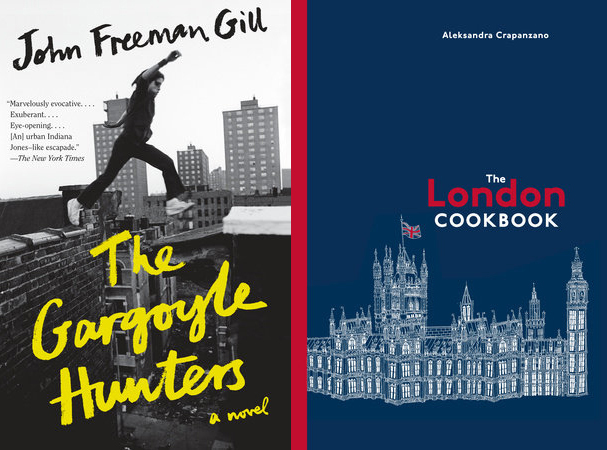
Book Notes
Reviews of books by John Freeman Gill ’84 and Aleksandra Crapanzano ’88
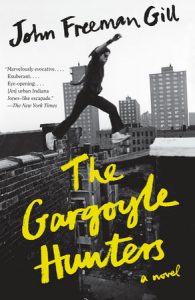
The Gargoyle Hunters
by John Freeman Gill ’84
Knopf
$27.95
Video Profile: Watch an interview with the author
“New York puts you in your place. It’s bigger than you and more important. It’s older than you, and newer too. It’s more than you: more towering, more gutter-level; more refined, more depraved; more timeless, more late for dinner reservations. It has a lot of moving parts and countless immovable ones. And it doesn’t care if you have a relationship with it or not.”
The Gargoyle Hunters is a funny story filled with the fascinating history of a vibrant and ever-evolving New York City. It will help you make sense of its craziness, as well as reflect on what parts are worth preserving. Thirteen-year-old Griffin reminds us of how colossal and crude New York City can be. In this coming-of-age story, we learn how Griffin deals with his parent’s divorce, high school love, and sibling rivalry. Amid all the drama, John Freeman Gill ’84 does a beautiful job of personifying the city and giving New York a voice as a main character in the novel. Although the story takes place in the 1970s, before my time growing up here, I found myself connecting to Gill’s description of the evolving city and Griffin’s experience in it as a young adult.
Griffin lives with his mother and sister in a brownstone filled with temporary boarders who flow in and out of the house like a crowded New York City subway car. Griffin’s mother is an artist who studied at Pratt Institute. I grew up in Clinton Hill, Brooklyn, across the street from Pratt and treated the campus as my playground. I have fond memories of spending summer afternoons exploring oversized sculptures made of wood, metal, and tire rubber. It didn’t surprise me to learn that Griffin’s mother’s medium is egg shells. Although Griffin doesn’t mind helping his mother sort the shades of her egg shells, what he longs for is quality time with his father.
“The lives lived by generations of New Yorkers in and around a historic building give it all kinds of layers of collective meaning—a patina of memory and grime and experience,” Griffin’s father says as he tries to explain his passion for salvaging New York City buildings and how he pays the mortgage on their brownstone home. He is determined to bestow on his son a knowledge and appreciation for architectural history, and so their journey of gargoyle hunting begins. Griffin’s size and stature makes him ideal for fitting into tight spaces and stealing gargoyles or other sculptures from abandoned buildings. Griffin develops a passion for exploring the city on his own and collecting artifacts.
I was captivated by Griffin’s father’s addiction for preserving such a specific aspect of New York City. I couldn’t help but compare Gill’s 1970 city demolition to the present-day gentrification and urban renewal that has changed downtown Brooklyn into a smaller Manhattan metropolis. The boom of high-rise apartment buildings, shopping complexes, and stadiums has drawn in more New Yorkers and tourists alike.
While reading Gill’s novel, I found myself getting lost in the nostalgia of Brooklyn during my childhood. In the early 1990s, New York was gritty and crime-ridden. Hip-hop culture had a dominating presence, from graffiti on subway cars to the Albee Square mall in downtown Brooklyn where I purchased my first nameplate necklace, an array of colorful belts, and a knock-off designer purse. Much like Griffin, when my parents allowed me to explore the city on my own I was enamored with its energy. I began to see and experience NYC for all its glory. And sometimes you need a reminder of its beauty. Gill’s story helps us to achieve just that.
Maya Grant
Associate Teacher, Grade One

The London Cookbook: Recipes from the Restaurants, Cafes, and Hole-in-the-Wall Gems of a Modern City
by Aleksandra Crapanzano ’88
Ten Speed Press
$35.00
Video Profile: Watch an interview with the author
I don’t judge a book by its cover, but by its opening sentence, and by that criterion this book is a winner! “It begins on a walk.” The London Cookbook by Trinity School alumna Aleksandra Crapanzano ’88 is as much a delicious, fascinating stroll through some exceptional restaurants and eateries in London as it is a cookbook. Crapanzano, a widely published and award-winning writer, spent part of her early childhood in London. Her love for the city she grew up in comes across brilliantly in her exceptional writing, decorated with wit and affection. Her “walk” through London’s diverse food culture highlights the shift in the culinary landscape of London in the past twenty years.
Crapanzano’s writing mantra is “write what you don’t know.” In preparation for this cookbook, Crapanzano asked friends in London for recommendations of restaurants and specific dishes. Based on those recommendations Crapanzano filled multiple notebooks with exhaustive notes and research into the restaurants, restaurateurs, chefs, and recipes. She is clearly an expert on her subject, and it is no surprise when you realize that this book has been written by an award-winning journalist. Her gastronomic travelogue takes you to India, Japan, Mexico, and Turkey, to name just a few destinations. The book can almost be used as a food guide for visitors to London. No imminent London travel plans? No worries; head to the kitchen!
The book is an impressive collection of recipes, each prefaced with a well-written and interesting backstory of the particular restaurant or chef. I especially enjoyed the many attractive color photographs of the food as well as some of the characters and establishments that are so central to the book. My copy is cluttered with yellow post-its, most of them primarily influenced by pages with mouth-watering photographs of food. There may be days ahead when, too tired to cook, I can picture myself curling up on the couch and satisfying myself with these beautiful, glossy pages.
Ultimately, The London Cookbook is a recipe book with over 100 recipes in its 281 pages, running the gamut from starters to cocktails. While many of the recipes sound “exotic” and internationally inspired, the British entries like “Welsh Rarebit” from St. John and “Fish and Chips” from Tom’s Kitchen, are wholesome and authentic and hold their own. These British classics share equal time with a risotto in red wine and pumpkin roasted with chile and oregano (The River Cafe) and “Garam Masala Christmas Pudding” (The Cinnamon Club).
Restaurant cooking is a very different animal from home cooking, but Crapanzano has adapted these recipes for a smaller scale and her modifications are perfectly suitable for the American kitchen. The proof of the pudding is in the eating. I hope the author will not mind my sharing her simple, “never fail” “Olive Oil Cake” with you. It’s an Italian, orange-flavored cake from the Towpath Cafe.
2 cups all-purpose flour
1 tablespoon baking powder
1½ cups sugar
3 eggs
⅔ cup great extra-virgin olive oil
¾ cup whole milk
1 to 2 teaspoons grated orange zest
Juice of 1 juicy orange
Preheat the oven to 350°F. Butter a 9-inch springform pan and line with parchment paper. Butter and flour the parchment paper and sides of the pan.
Stir the flour and baking powder in a small bowl. Beat the eggs in a large bowl with an electric beater, along with the sugar until pale yellow. Add olive oil, milk, and orange zest and juice. Beat for another minute or two. Add flour mixture and stir by hand until just blended.
Pour batter into the pan and bake for 45 minutes, until golden brown and a knife inserted comes out clean. Enjoy warm or cool.
The London Cookbook is a great addition to my collection of recipe books. It will make a perfect gift either for yourself or for the food enthusiast on your list. Do yourself a favor and grab a copy soon.
Vanaja Zacharopoulos
Teacher of Science
Recent Alumni and Faculty Books
Cynthia Carris Alonso ’81
A Taste of Cuba: A Journey Through Cuba and Its Savory Cuisine
Apollo Publishers, 2018
Allan Appel
The Book of Norman
Mandel Vilar Press, 2017
Diane Linder Berman and David J. Connor A Child
A Family, A School, A Community: A Tale of Inclusive Education
Peter Lang Inc., International Academic Publishers, 2017
Steven Bloom
Das positivste Wort der englischen Sprache: Roman
Wallstein, 2015
Michael de Guzman ’56
The Boy from Somewhere Else
CreateSpace Independent Publishing Platform, 2018
Andrew McCarron
The Ballad of Sara and Thor: A Novella
Barrytown/Station Hill Press, 2017
Kristina Pérez ’98
Sweet Black Waves
Imprint/Macmillan, 2018
Catherine Price ’97
How to Break Up with Your Phone: The 30-Day Plan to Take Back Your Life
Ten Speed Press, 2018
Mindfulness: A Journal Diary
Clarkson Potter (Jou edition), 2016
Wayne Riker ’68
50 Years 50 Bands 50 Bucks: Memoirs of An Unlikely Musical Journey
CreateSpace Independent Publishing Platform, 2016
Karen Shepard ’83
Kiss Me Someone: Stories
Tin House Books, 2017
David L. Ulin ’79
The Lost Art of Reading: Books and Resistance in a Troubled Time
Sasquatch Books, 2018
Sidewalking: Coming to Terms with Los Angeles
University of California Press, 2015


Classroom Comment – Oscar Hansen ’23
Classroom Comment
A Grade Eight student writes about his engagement with soccer.
By Oscar Hansen ’23
Favorite Book Series: The Hunger Games Trilogy by Suzanne Collins
Favorite Movie: The Parent Trap
Favorite Song: Wonderwall by Oasis
The first time that I wanted to play soccer was in first grade because my two best friends at the time played for a small team on Randall’s Island. The instant that I saw how much fun they were having I immediately begged my mom to let me play with them. My mom, being the loving and supporting person that she is, went out to the store and bought me a pair of Sambas from Adidas. The next weekend my mom drove me in a car with my two best friends to Randall’s Island for our soccer match. The moment that I stepped onto the pitch and played my first organized game of soccer I became engaged with the sport. Imagine a short, curly haired, red-headed kid running around on a patchy, muddy soccer field with a smile on his face from ear to ear. I knew that I wanted to play soccer for the rest of my life.
Fast forward two years, in third grade I wanted to take soccer more seriously so I tried out for and was accepted to the Red Bull’s travel soccer academy. This meant longer and harder practices during the week and games on the weekend with people who actually wanted to play soccer, not just with kids whose moms forced them to play a sport. I gladly took this challenge and showed up to every practice and every game, trying my hardest every time I set foot onto the soccer field. This hard work and dedication brought me all the way up to the Red Bull’s A team for the best players in the academy. I played on the A team for about three more years until I got burnt out. I stopped enjoying the game of soccer, and because of that I started to skip practices, games and even important tournaments that my teammates needed me in. I felt depressed because I had always wanted to become a professional soccer player and not having that engagement with soccer in my life anymore overwhelmed me. I felt as though my life didn’t have much of a purpose anymore. I never knew what to do with my day; I tried to play other sports like basketball but none of them really clicked with me as soccer always did. Due to my lack of effort and participation during practices, I was moved down to the B team of the Red Bull’s. When I got this news I was even more devastated, but something sparked in me. I realized that to me engagement means showing up to practice every day and trying your hardest even when you are feeling out of it. The minute that I discovered this I began to do my best in practice and show up to every game no matter if I didn’t want to because I knew that soccer was always going to be there for me and so I had to be there for it.
Today I am in eighth grade at Trinity School. I play for the Red Bull’s A team and the Trinity gold team. I don’t know where soccer will take me in the future but if I stay engaged, I know that it will be something spectacular.

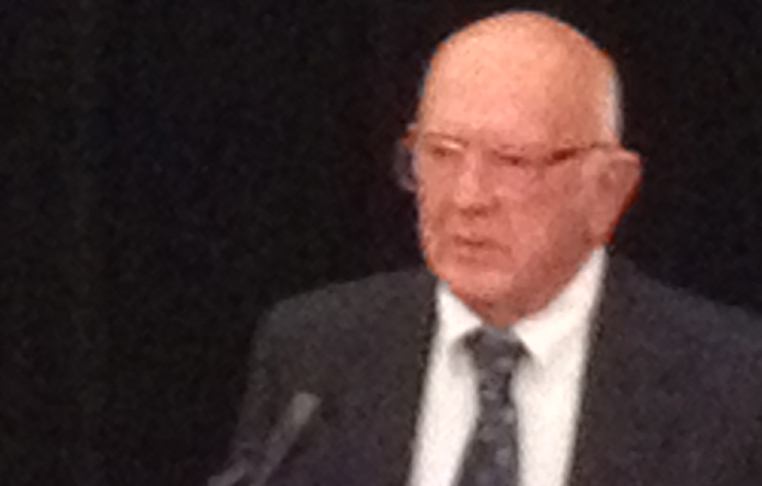
Richard Garten ’39, Dies, Created the Foundation for Trini...
Richard M. Garten ’39, the twenty-fourth headmaster of Trinity School, died on 5 April 2019, in Jacksonville, Florida.
He was born on 7 October 1921. A native New Yorker, he graduated from Trinity School in 1939. He received his BA in 1943 and an MA in history in 1947 from Columbia University. He was a teacher of history at Riverdale Country School, and was the headmaster of three independent schools: Park School in Indianapolis, Indiana, from 1960-1964; Trinity School from 1964-1975; and Gulf Stream School in Gulf Stream, Florida, from 1975-1987. He received his EdD from Florida Atlantic University in 1987.
His tenure at Trinity marked a notable time in the School’s history: Trinity returned to coeducation after 129 years, accepting girls in 1971; Kindergarten was added; and the School participated in the West Side Urban Renewal Project by building the Hawley Wing and Trinity House. In overseeing a significant transformation and expansion of the student body, faculty, academics, curriculum, and facilities, he fostered advancement within all aspects of the School, as well as the community. An organization he founded in the early 1960s, Broad Jump, which provided academic enrichment to students in public schools, was a forerunner and partner of Prep for Prep. During his leadership he was successful in bridging the traditions of the School with the social and cultural changes of the era. With these many initiatives, Garten was the creator of the modern Trinity School.
“Dick Garten impacted my life in so many ways and I will forever be grateful to him,” said Andrea Colvin Roberts ’73, the first woman to graduate from Trinity after its return to coeducation and now a trustee of the School. “He was extraordinary to me from the time that he admitted me to Trinity and told me I did not have to take geometry again (which I would have failed for sure) and mentored me in history. He was always a great friend to me over all these years. I will really miss him.”
“I got to know Dick over the past twenty years through regular correspondence around his birthday and at the holidays each year, and the occasional visit” says Associate Head of School for Advancement Myles Amend. “He read school publications cover-to-cover, and maintained a lively interest in all things Trinity. One of the most moving things I ever saw was the extended standing ovation he received in the Trinity School Chapel when he was introduced at the 40 Years of Women at Trinity event in 2013.”
Garten is predeceased by his wife, Jean. He is survived by his three children, Christopher P. Garten ’74, Victoria Garten Wilcox ’75, and Richard Gray Garten ’80.
His son, Christopher, writes that his father had “a long, full, and meaningful life, with work and family he loved.”

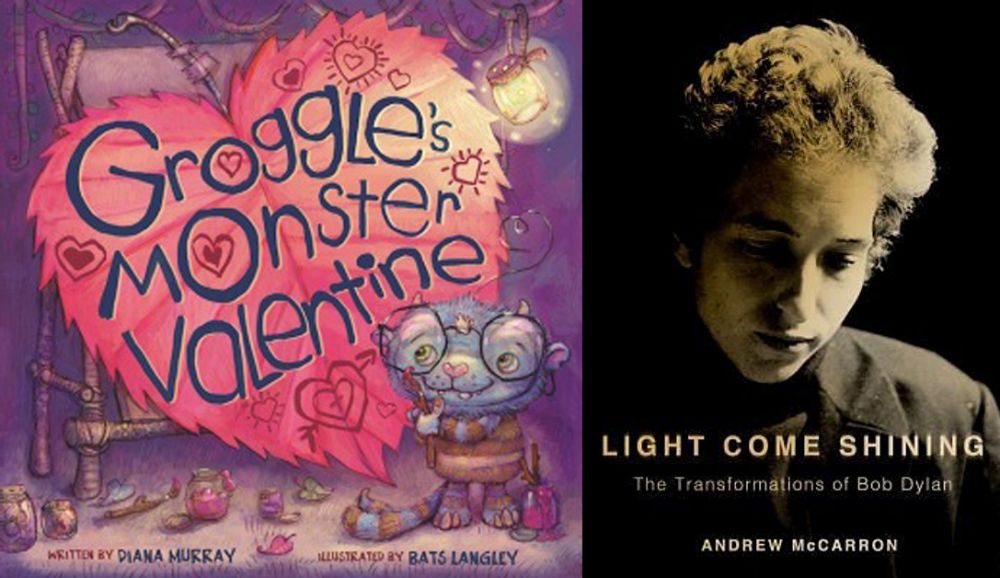
Book Notes
Reviews of books by Diana Murray ’90 and Andrew McCarron, Head of Religion, Philosophy, & Ethics Department
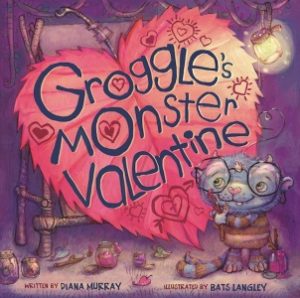
Groggle’s Monster Valentine
by Diana Murray ’90
Sky Pony Press
$9.99
Video Profile: Watch an interview with the author
Did you know that monsters celebrate Valentine’s Day? If you are thinking of roses and chocolate, you are in for many surprises when you meet Diana Murray’s character Groggle, an adorable furry monster with a pink heart-shaped nose who is searching for the perfect valentine for Snarlina, his “beast” friend in the whole wide world. Murray’s fourth picture book, Groggle’s Monster Valentine, is not only a beautifully illustrated and cleverly written story to read aloud to children on Valentine’s Day, but also a resourceful mentor text that Lower School teachers can use to teach literary devices to their young readers and writers.
Although I have yet to read aloud Groggle’s Monster Valentine to our Kindergarten students, I am certain it will become one of their favorite Valentine’s Day picture books. Much like adult readers, children love stories that strike a balance between relatability and unpredictability. Murray has a keen insight into how to let her readers relate to Groggle and also knows when and how to surprise her unsuspecting readers.
In the book, Groggle has been up till the wee hours on Valentine’s night working on his cards for Snarlina. Ask any Lower School student, and they can share with you that making even the simplest valentines, let alone some elaborate ones, for your entire class will take longer than you imagined. Groggle collects some bog slime and carefully squirts everything he wants to say in bold, gooey letters. He sprinkles on shiny beetle glitter and gingerly ties on snake bows to decorate his cards. Groggle pours in all this time and effort, to no avail, all due to his monster appetite! Gobble, crunch, crunch, slurp—he scarfs down his card before his bog slime ink has even dried! Not many will know what it is like to guzzle cards like Groggle, but it’s an entirely different matter when it comes to sweets—after all, what fun is it to make valentines without munching on one too many Hershey’s Kisses? After the seventh failed attempt at curbing his monstrous appetite, Groggle decides to hurry over to Snarlina’s with what is left of his last card—slobbery and wrinkled with one smudged word left for her to read: “friend.” When readers meet Snarlina for the first time, she is a sight to behold. Who would have thought Snarlina to be a one-eyed monster that is quadruple the size of Groggle, with deadly fangs and claws? How will she respond to Groggle’s half-eaten valentine? I can just imagine our young readers holding their breaths, fearing the fate of our adorable furry friend Groggle. However, as soon as she sees Groggle at her doorstep, she purrs like a kitten, beams from ear to ear, giddily stomps her hairy feet, and gives him a monster hug after plopping the card in her mouth! Nyum, nyum, nyum, gulp! Murray has taken a somewhat clichéd topic and has created an entirely original narrative that conveys a heartwarming message that your best effort and intentions will be recognized and appreciated.
While children will be smitten with Murray’s whimsical characters and Bats Langley’s magical rendition of them, Lower School teachers will value this book for another reason: Groggle’s Monster Valentine is a great tool for teaching writing. The simple letters that Groggle writes to Snarlina are a great model to teach the basic format of letter writing to beginning writers.
Every April, which is National Poetry Month, this book needs to be on constant display in the classroom. It provides a humorous example of an acrostic poem, not to mention the plethora of examples of rhymes and alliteration that Groggle uses in his poems: “Roses are red, Garbage is grimy, Here is your valentine, Icky and slimy” or “Your teeth are so green. You’re the prettiest monster that I’ve ever seen.” Murray explicitly wrote on her Web site’s homepage that she “especially love[s] writing in rhyming verse,” and to make teaching rhymes even easier, the words that rhyme pop out from the page since they are highlighted in matching colors! Also, the series of sounds that Groggle and Snarlina make while they munch on their valentines—gobble, crunch, burp, slurp—are perfect examples of onomatopoeia. Last but not least, Murray’s frequent useof oxymorons like “horridly fabulous” and “monstrously super” is in line with the paradoxical motif of a tiny cute monster professing his love to an ill-tempered and nasty beast who drools.
If you are in search for a funny and refreshing Valentine’s Day picture book to read with your little monster(s) at home or at school, grab a copy of Groggle’s Monster Valentine for an awfully delightful experience.
Caroline (Kyung-Eun) Lee
Teacher of Kindergarten
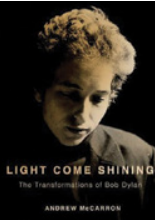
Light Come Shining
by Andrew McCarron
Oxford University Press
$19.99
Video Profile: Watch an interview with the author
When I was asked to write a review for Andrew McCarron’s new book, Light Come Shining, I took the opportunity to reacquaint myself with Bob Dylan’s extensive body of work. Having lived through the 1960s, toured in a band with my husband for seven years, and raised a family of musicians, I have experienced Dylan’s monumental impact on American music and culture from different viewpoints in my life. But to listen to his work again, this time accompanied by McCarron’s insights, was an experience altogether new.
McCarron is aware—and makes sure the reader knows that he is aware—that his book is a new addition to already exhaustive library of Dylan exposés. McCarron insists, however, that his approach, the “psychobiography,” sheds a different light onto an already overexposed subject matter. The central assumption of McCarron’s psychobiographical method is that, by analyzing key moments in a person’s life, one can create a holistic portrait, or what McCarron calls a “common script.” McCarron’s project is especially apt for a figure such as Bob Dylan, whose famous transformations and conflicting identities have dumbfounded many a fan and critic. In addition, the mountain of speculation, rumor, and fanaticized theory-making surrounding Dylan has elevated the artist to legendary, almost mythical status, making Dylan himself indecipherable to the point of mysticism. McCarron aims to undercut the noise with this psychobiography, certain that somewhere in Dylan’s many transformations and manipulations lies the common script of his life.
McCarron’s exposé focuses on three defining moments in Dylan’s life: his 1966 motorcycle “accident” in Woodstock, New York; his religious conversion during the born-again movement of the 1970s; and his midlife recommitment to songwriting and performance starting in 1987. To many a fan and analyst, these turning points represent points of major personal and artistic changes and add to the Dylan mystique. To McCarron, they offer key turning points, but instead of seeing chaos, he sees a common thread: “The best place to find Dylan’s unique psychological fingerprint is within the twists and turns of his changes.”
McCarron also explores Dylan’s coping mechanisms in dealing with the insurmountable difficulty of separating his personal life from his public life—a common theme among celebrities. Dylan would don outlandish attire—a blond wig, dark glasses, a skull-cap—to hide his identity. Because of the constant public intrusion into his life, Dylan became a “paranoid recluse,” whose eccentric lifestyle also became part of his mystique. Yet McCarron again sees these transformations as an opportunity to reveal a common thread, surmising that “although there is little doubt that some of his masks are calculated stunts and tricks of a wily performance artist, his appropriations are important expressions of his deeper sense of self and identity.”
No doubt, though, that Dylan manipulated the script of his past to create a more alluring public persona. He hit the New York music scene as a fully formed fictional character. He manipulated the details of his life to enhance his own story. Dylan’s transformations were not just cosmetic—they seemed to permeate into his internal life. McCarron relays that there was sincerity about Dylan’s quest for self-knowledge, often taking the form of religious experiences that Dylan refers to in his writing: “A God of time and space— that creates people with specific destinies in mind.”
Light Come Shining is McCarron’s ambitious venture to see logic where others see chaos, to find a common thread when others are bewildered by Dylan’s existential meanderings. McCarron’s prose is at times intimidating for readers unacquainted with academic psychology, as well as for those non-initiated in the literature surrounding Bob Dylan. Still, whether you are a fan of Dylan, McCarron’s psychobiography is well worth reading. I recommend reading it as I did—while listening along to Dylan’s work as it is referenced in the book. If you are familiar with Dylan’s work, McCarron provides refreshing context for listening and experiencing Bob Dylan anew. If you are uninitiated, this book can be your curator through your exploration of the artist’s legacy and intimidatingly expansive body of work.
Sandy Jenkins
Teacher of Grade Two
1993-2018
Recent Alumni and Faculty Books
Deyan Ranko Brashich ’58
Dispatches
New Meridian Arts, 2017
Nicholas T. “Nick” Bruel ’83
Bad Kitty Camp Daze
Roaring Brook Press, 2018
Samuel Charap ’98
Everyone Loses: The Ukraine Crisis and the Ruinous Contest for Post-Soviet Eurasia
Routledge, 2017
Aleksandra Crapanzano ’88
The London Cookbook: Recipes from the Restaurants, Cafes, and Hole-in-the-Wall Gems of a Modern City
Ten Speed Press, 2016
Michael de Guzman ’56
Cosmos DeSoto’s Last Case
Createspace Independent Publishing Platform, 2017
John Freeman Gill ’84
The Gargoyle Hunters
Knopf, 2017
William G. Franklin ’63
What is UP, Doc? Ruminations of a Solo Cardiologist
Createspace Independent Publishing Platform, 2017
Alexandra “Alex” Fribourg ’00
(writing as A.F. Brady)
The Blind
Park Row Books, 2017
Vincent Katz ’78
Southness
Lunar Chandelier Press, 2016
William Green Miller ’49
A Wreath of Friends
Oxford: Amaté Press, 2007
Diana Murray ’90
Doris the Bookasaurus
Macmillan, 2016
Grimelda and the
Spooktacular Pet Show
Katherine Tegen Books/ Harpercollins, 2016
William F. Pepper ’55
The Plot to Kill King: The Truth Behind the Assassination of Martin Luther King Jr.
Skyhorse Publishing, 2016
Diana H. Polley ’88
Echoes of Emerson: Rethinking Realism in Twain, James, Wharton, and Cather
University of Alabama Press, 2017

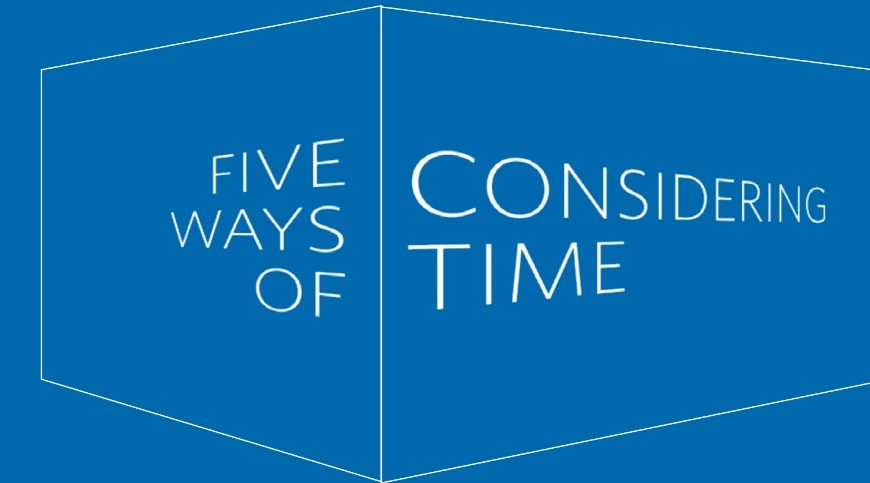
Five Ways of Considering Time
By Katherine Lee and Kevin D. Ramsey
Five alumni artists discuss the ways in which they think of time, use time, and incorporate time into their works. Tanaz Eshaghian ’92, Nadia Ghent ’75, Judy Glantzman ’74, Lizzie B. Hutton ’91, and Vincent Katz ’78 describe the ways in which time is an essential part of the creative process.
Tanaz Eshaghian looks through the lens of time at her own life and acknowledges that her narrative is not conventional. “I was not your average Trinity student,” Eshaghian says. “As a mother, looking at how my children are growing up, I see the difference. My kids are in first grade and pre-kindergarten at this nice school in Manhattan, and sometimes I’ll say to them: ‘Your mother was just learning English around your age.’”
Eshaghian left Iran at the age of six with her mother. “When we first left Iran, we went to Europe because Iran and the US had cut off relations and there were no flights to America,” she recalls. “We went to Italy, and then we went to Spain, and then Canada. All the while, we were trying to get a visa to go to the States.” Because of the frequent moves, Eshaghian repeated first grade in three countries. “I went to first grade in Iran, and then I went to first grade in Spain, and then I went to first grade in Canada,” she says, noting that it didn’t bother her at the time because she was simply going with the flow. “My mom likes to tell this story about when we were in Madrid. She came home one day and I was playing with this other little Iranian kid who was staying in this same hotel complex, where everyone was waiting for their visas. We were playing ‘consulate and person requesting a visa,’ and I refused to give him a visa. I would say, ‘No, I’m sorry, your paperwork doesn’t add up. You can go back to Iran and be fine.’”
But the visas did eventually come through, and once the family arrived in the United States, Eshaghian acclimated quickly. “When we finally got to the US, we arrived in Los Angeles—but soon we moved to New York,” she says. “The school in New York put me in second grade for three months, and then moved me to third grade. It was an interesting time. I remember watching The Smurfs the whole weekend straight and picking up some English right away. Watching cartoons is a great way to learn English.
“So that was my experience as a little seven-year-old,” she says, laughing. “Whereas my children are enjoying the standard New York upbringing with play dates, and activities, and school.”
Working now as a documentary filmmaker, Eshaghian is fascinated by her inability to remember much of her own early childhood.
“I don’t recall much of Tehran from my childhood,” Eshaghian says. “It’s a little bit strange. I don’t recall much of anything, and it’s always haunted me. I have some vague memories of a staircase, my house, sort of a memory of my uncle’s home, their dog. That’s about it. I don’t honestly know what’s a memory of my time in Iran and what’s made up, drawn from things I’ve heard or been told.”
Ten years ago, she traveled back to Tehran as an adult—her first time in the country in twenty-five years. “It felt like the first time being there,” she says. “Going to a country where you speak the language and know the culture, but you have no idea where you are—it’s actually amazing. I realized I had this ability to navigate through the place while also seeing things from an outsider’s perspective. It was a very multilayered, satisfying experience. I loved it, even though it played strange games with my notion of time and memory.”
Love Iranian-American Style was a project she started when she was in her mid-twenties, when her well-intentioned but anxious family began to push the idea of an arranged marriage. “My first film was about my Iranian family trying to marry me off in a traditional way after I’d grown up in Manhattan, gone to Trinity, and graduated from Brown,” she says. “My attitude was, ‘You’re kidding, right? How am I supposed to now be that woman?’”
The film explored her thoughts about her own Iranian-American identity as a young woman and what it meant to grow up immersed in western culture while surrounded and supported by her loving, Iranian family. The film also featured interviews with former boyfriends, in which she asked the men why their relationships hadn’t worked out. For Eshaghian, understanding her divided identity required a deep dive—not into her own memory, but into the memories and cultural understandings of the people who surround and support her. And on that journey, she discovered, too, that her “ability to navigate through the place while also seeing things from an outsider’s perspective” was what made her such an effective documentarian.
The inspiration for Eshaghian’s film Love Crimes in Kabul came from considering the effects of cultural expectations of women in even more fraught circumstances. Eshaghian began the project after reading several articles about the practice of prosecuting young women for “moral crimes.”
“In Afghanistan there are very, very strict cultural laws that lead to an ingrained understanding of how you behave...it’s very traditional,” she says. “As a woman in Afghanistan, you usually marry at a young age, and you marry the person your family chooses for you. These women who have committed ‘moral crimes’ have transgressed that tradition. For example, this woman liked her neighbor. She thought her neighbor was cute and so she pursued him, creating a moral mess.
“The perception of transgression is clearly tied to gender,” she says. “When I talked to the women and heard their stories, I thought, ‘This is fascinating, these women are rebels.’ The idea perpetuated in western media of the poor little Afghan victim was not accurate.”
Shaping the narratives for western audiences required a balance of practical timing and an understanding of emotional narrative. When she went to the women’s prison in Kabul for filming, Eshaghian knew she wanted to talk to women who were still awaiting trial. “I’m capturing a particular story in their lives,” she says, “so as the women move on to the next chapter, it becomes a different story. I can tell where the story I’m telling ends and where the new one’s going to begin.”
Other challenges involved finding women who were willing to talk to her, or holding her emotions in check when witnessing injustice. But at least one story had a gratifying end. “I filmed the girl who was in prison for having relations with her male neighbor outside of marriage,” she says. “Both she and the neighbor went to trial, and they decide to get married. The judge says, ‘Since you’re going to get married, you’re cleaning up this mess you’ve created. You’re sentenced to time already served. Get out of here. Go home, start a family.’ So then, they’re starting a family, a new beginning. My part in the story is over.”
From her perspective, Eshaghian believes her role is to craft a narrative that will allow viewers to invest in her subjects’ lives. Even with nonfiction, there are storytelling techniques that can help. “Sometimes there are ways of changing the order of time in a documentary, little things that you can do to help come to an emotional truth of the story even if it’s not the exact order of when things occurred,” Eshaghian says. “You can reverse sequences, come back to earlier interviews, because it helps the audience make sense of who this person is, what their story is. The narrative is emotional and so I’m always most focused on what makes sense emotionally and how to best communicate that to the audience. To me, that’s the point of doing films,” she says. “It’s an emotional medium. It’s not so much about information...identifying what happened first and second...as it is about exploring the life of the subject.”
Musician and Writer
One of the highlights of Nadia Ghent’s career as a violinist was a performance of the John Cage piece Atlas Eclipticalis at Carnegie Hall in 1992. “Cage died just a couple of weeks after the performance,” she recalls. “The performance was of a large-scale piece called Eclipticalis, based on star charts and musical notes corresponding to stars.”
Because of the composition’s unconventional structure, Ghent says the conductor’s role was to direct the timing and unfolding of the piece. The musicians themselves were held in anticipation of how long the entire performance would be.
“The performance was at Carnegie Hall,” Ghent says, “and everybody who plays at Carnegie knows that there’s a certain time limit on anything that happens on the stage that is enforced by the stagehand union. A performance that goes even one second over the allotted amount of time gets hit with huge fines. So all of us were talking about whether it was going to go overtime and wondering if the stagehands would come out and make the performance stop because there was some speculation about the performance going on for six hours.”
Ghent had her own concerns regarding the length of the performance. “The other issue was that, at the time, I was pregnant with my first child and I was really worried about being able to get to the bathroom,” she says. “When one is pregnant, not being able to get to the bathroom can be a constant concern. I was wondering, ‘Can I sneak off the stage? Will anybody notice?’ I mean, that was delusional. Of course people would notice.” She laughs. The performance ended up running just over two-and-a-half hours and, she says, “I remained on the stage the entire time.
“When you play a Beethoven symphony, you know that in a certain number of minutes you’re coming to the double bar and the performance will be over,” Ghent says. “It might go a little slower, it might go faster, but there’s an end to it that’s definite. With Eclipticalis, there was no definite ending to it until it finally did end. It was an incredible experience to be in the middle of that soundscape. It was a timeless experience, because nobody knew when it was going to end, so you had to give yourself over to that sense of nonlinear time.”
Over twenty-six years, Ghent’s love of music endured but required flexibility, resilience, and her own evolution. When her husband accepted a job in Southern California, she was willing to make the move, but was confronted by the realities for a freelance musician: opportunities were fewer and farther between, and the arts culture was unequal to that of New York City. Over time, she found that being around young people as they discovered their own love for music was incredibly fulfilling and she became a music teacher. But then, the family had to move again.
“My husband got a very good job offer back here in Rochester, so we packed everything up and moved,” Ghent says. “Unfortunately, we moved at a very bad time for my children. My daughter was in the middle of high school, and the timing for her, at that point, was just awful, so I really had to put aside a lot of my career—everything that I’d built up as a teacher and as a violinist—and really spent a lot of time helping her. I felt she needed me to be present. Just to be there in case she needed to yell at me or something.”
That was when Ghent found writing. “I realized that I had lost a lot by leaving behind parts of my life,” she says. “I was just sort of sitting here waiting. And I started writing and reading. I took a couple of very interesting online poetry classes. At that time, these massive open online courses were getting really popular, and there was one out of the University of Pennsylvania that caught my eye: Modern and Contemporary Poetry—including poetry and writing by John Cage.”
Ghent instantly felt that she was on familiar territory, even while giving herself over to something completely new. “I had never known that he actually wrote language, words, you know. I only knew him as a composer of music,” she says. “So I really started to experience the whole contemporary music scene from a totally different angle, from the angle of the poets and the writers who were writing, at that same time, and Cage, who sort of bridged both.”
The meeting of old and new jostled her memory and reignited her passion for creative expression. “Studying poetry drew me back to what I had left behind so many years ago,” she says, “and I started writing a lot more and refocusing my intentions.”
Ghent’s current writing project tackles the idea of her various dislocations in both the physical moves and abrupt changes throughout her professional and creative career. “I had never lived anywhere but New York before we moved to California, so that was my first dislocation, and then we did it again and relocated here to Rochester, another dislocation,” she says. “I began thinking about all the places that were significant to me in New York and all the different experiences that I had in different neighborhoods and how that shaped me as a person.”
The project involves physically revisiting those spaces and thinking about those times in her life. “Every month, I’m revisiting an old house or building where I used to live,” she says, “or some significant place where my body had been for a significant amount of time. Then I write about that place, both as a memory, what I remember, and how it exists now in present time. The intersection between what’s remembered and what’s real—that’s what I experience now.”
The intersection between memory and the way she perceives those places in the present can feel abstract and confusing. “In many regards, the remembered place has more presence in my life and my memory than the place as it exists after time has passed,” she says. “There are good memories of a place that one has lived, but even the bad memories give sort of a burnished quality to things. So physically visiting all these places from my past has been very disorienting, because I feel as though I don’t really belong there anymore. Yet so much of my history has been in a place that’s no longer part of my current existence.”
But Ghent finds that articulating some of that feeling has generated useful and profound realizations. “I want to break apart the cliché of ‘You can’t go home again,’” she says. “You know, we can hop from place to place, or career to career, or identity to identity, but there’s something that continues and links it all together—and that’s the ability to look back on what has been left and honor it.
“It’s a way of having continuity with things that have passed,” she continues. “I’ve left behind certain parts of my life. My children are grown up, and they’re leaving to begin their own adult lives. So there’s definitely a sense of wistfulness, going back to those places where they were young. But revisiting those places now feels like retaining what had been very precious and very important and honoring those memories.”
Acknowledging the memories also gives Ghent permission not to be afraid to live in the present as a writer. “Looking back gives me something to capture in language now,” she says. “It’s sort of a mining operation for the present existence here, and in a way that makes those histories less fraught. There’s a lot of negative qualities associated with uprooting and dislocating and leaving, but acknowledging the meaningful within those memories gives more weight to my experience...more than simply thinking ‘I had to end it and do something else.’”
From her time as a violinist, Ghent confirms that a significant part of a musician’s role is in translating classical music for the ears of contemporary audiences. “Even the tonality of music has shifted over time,” she says, “so the note that we call A used to be at a different pitch just 150 years ago. And rhythm was not standardized until around Beethoven’s time. Some of the metronome markings that he would notate in his scores are practically impossible to reproduce. In fact, the metronomes that were produced then didn’t seem to be completely accurate—or perhaps the difficulty was that Beethoven couldn’t hear it.” According to Ghent, the modern instruments used now sound very different from instruments in earlier centuries. “That’s part of the way that music needs to evolve so that we can bring that composer into the present time across a span of centuries.
“Again, this brings me back a bit to John Cage and his idea of using the star charts. In a way, it’s the same concept as the light from stars,” she says excitedly. “The light we see has been traveling for millions and millions of years, and throughout that time so much has changed. Civilizations have changed. But the light is still coming to us, and we see it in our present time—something that began its journey such a long time ago.”
She beams. “In music we’re doing something similar. We’re bringing a language from a different era to our audiences in their language.” How those audiences receive it is just as sublime. “I was pregnant when I was performing that John Cage piece from the star charts,” she says, “and that child is now in the astrophysics PhD program at Berkeley! I tell myself it’s because of early exposure to the whole idea.”
Astrophysics, John Glenn, and my Father by Nadia Ghent ’75
In the city, the stars disappear. Light traveling from the most distant galaxies becomes diffuse, like dust, a pale light scattered across the evening sky. He asks me what I see when I look up, between the Empire State Building and the rooftops, and I tip my head back so far that I think I will fall backwards onto the pavement. He steadies me, holds my hand. He asks how long I think it’s been since that light first started its journey to our eyes, when it was that the starlight began to shine, and I can think of only one thing: how long will he be my father before time runs out? Nothing is containable.
The ancient Greeks looked out into the darkness of their sky that reflected back what they imagined they would see: a dog, a dipper, a bear, a lyre. I see a large man outlined in the light, I see only my father looking for the stars. To the Greeks, that broad stretch of pale dusty luster stretching across the night sky looked like milk spilling from the center of the universe. Once spilled, never contained. And then the Via Galactea becomes our Milky Way, the word “galaxy” traveling through time like that light, thousands or millions of years of distance and language and space. On Saturdays, he takes me to the Hayden Planetarium and brings me home late, when it is already night.
I am anxious about time, and how often he is late. He is always late. Light traveling from the most distant galaxy has been in motion for 14 billion years. Each week I travel between my mother and my father, one eclipsing the other, each week navigating this distance that only lengthens over time. How much time will pass before I know that he is anxious too, the way these few hours of fatherhood will slip through his fingers, hours collapsing into minutes into seconds that are linear, in motion, irretrievable. Each week, I watch for him from the window, waiting. In divorce, there is a custodial parent and a non-custodial parent, and I think of custodians and their brooms sweeping away our broken family.
At the planetarium, we watch the sky show, the illuminated points of light above my head that stand in for stars. Some of the lights don’t work, and there are cracks in the plaster of the domed ceiling. I know the outlines around the constellations are not real, that when he whispers in the dark to me that he would like to be John Glenn, it is not real, that words like milk and galaxy and father will change and soon mean something else, that time will pass and I will not remember what he meant.
He wants to be John Glenn, the hero-astronaut circling the Earth three times in 1962, his plunge on fire back to the sea, the way the spacecraft bobbed on top of the waves. He was brave, he was rescued, he didn’t die. His wife and children and everybody loved him. It was because of friction, my father explains to me, the force of the atmosphere against the heat shield, how hot it must have been inside. What did John Glenn see outside the capsule window before descending? Did he see an infinite dark beyond the blue, how light throbbed towards him and then receded on every orbit? He saw what’s out there, my father says, imagine what he saw, and he has tacked a picture of John Glenn he’s torn out from Life Magazine on his apartment wall. In his apartment there is John Glenn’s picture, a bed, a chair, a plate, a fork, a knife. Imagine what’s out there, he says.
You can be a scientist, he tells me, girls can be astronomers too. You’ll be the Madame Curie of the telescope! You’ll go to the moon in the year 2000! Women will be astronauts and walk on Mars! But I can’t see in the dark, there are cracks in the ceiling, the outlines are not real. When the lights come up, he’s gone.
What is the nature of bodies long in orbit? Even light changes as it travels, and words change meaning over time. Milk becomes galaxy, father becomes absence. Spilled becomes uncontainable scattering across the evening sky. In the city, it’s too bright to see the stars. Imagine them, he says, as we look up beyond the rooftops, as his hand slips out of mine, imagine that you can. They’re there, he says, they’re always there.
Visual Artist
Judy Glantzman is a visual artist working in painting, drawing, and sculpture. Her work often references time in its process, in the “incidental,” in personal and political history, and in the interplay between viewer and artist. Recently, Glantzman was the Dartmouth College Winter 2018 Artist-in-Residence.
“When my mom died in April of last year, I was teaching at three different places, five days a week,” Glantzman says. “I would find time to work while commuting on the train. I would fold up these giant pictures, put them in my backpack, and if I was going up to RISD [Rhode Island School of Design], for example, I’d have four hours of train ride during which I could work very quietly on one little teeny drawing for that amount of time.”
The work, unfolded, is a large, continuous work—a patchwork representation of her practice in compartmentalizing. By comparison, Glantzman’s residency at Dartmouth College has been a very different experience: Her studio is spacious, and her day is unlimited.
“Here, I have no time restraints, and what I find that I’m doing more than ever before is that I’m working for twelve or fourteen hours every day,” she says. “There’s nothing for me to do except be in the studio.”
The generous time allowance has changed her approach—and her process—dramatically.
“Prior to coming here, I would do a lot to each piece whenever I could get my hands on it. I had a sense of the limited amount of time I had,” she explains. “Here, I find myself doing less to each of the images, going much slower.” The pace is less frenetic, but she is as prolific as ever. “I have a new clarity about my work,” Glantzman says. “I’ve started carving hands out of wood, slightly larger than life size. I’m making these little drawings on plaster. I’m making giant drawings on paper. The paper pieces are made on a very long roll of beautiful paper, and when I look at them now, I think of them as being a kind of sequence. I’m making ceramic heads, and I think of those as being sort of props for the drawing, so everything is interwoven. It’s one giant piece.”
She shares artist Phillip Guston’s painting philosophy, as a parallel to her own most satisfying processes: “When you’re in the studio painting, there are a lot of people in there with you—your teachers, friends, painters from history, critics—and one by one if you’re really painting, they walk out. And if you’re really painting, you walk out.”
“I love that Guston quote,” Glantzman says. “I think it can be hard to understand, but I feel that for me—and this relates to my age—I used to say that I chose to make the figure as a means of representing emotion, as if emotion was ephemeral, and the figure was a solid thing. Over time I’ve recognized how ephemeral the body actually is, and that it isn’t really a solid thing. It’s undoing itself, changing constantly, and then it will disappear or become something else.”
The practice itself has started to feel more spiritual than corporeal. “My new pieces feel very much as though I am participating in something,” Glantzman says, “but they don’t look like ‘mine.’ They don’t feel like my stamp on something. They’re not reflecting me so much as I’m communing with them.”
The process may seem slow and laborious, but revelation can strike in an instant. “A funny thing happened, because I accidentally had a spill of India ink. I picked it up with a paper towel, and then I had this piece of paper towel, and, for whatever reason, I just kind of threw it at a piece of paper, and it made a beautiful impression,” Glantzman says. “That made me think about the accident or the incident as something I was interested in recording. Because it’s not simply imposing my will on the image, but to make things that people wouldn’t necessarily notice, adding beauty to those moments.”
Glantzman feels those micro-moments are worth preserving, as a way of observing and elevating the unnoticed, gone-in-an-instant flashes, and cataloging them into human experience worth remembering.
“Artists provide a revelatory way of seeing something that already exists in the world,” she says. “Art itself is a means of slowing down time to allow perception to happen—to receive all the impulses or information or colors or shapes that you are experiencing.”
Those relationships take time to process and transfer to paper or canvas.
“In an observational drawing,” Glantzman says, “you’re sitting in front of something and you’re trying to record it. You have to slow your eye down, just to take in visual information. This shape here relates back to this other shape. These colors are black and white, and relate to this gray in a different way—whatever the sets of relationships are.”
Even when describing an object literally, each observation—whether voiced aloud or transferred to paper—can set off endless bursts of connection, resonance, and communion. For Glantzman, this journey represents some of the joys and challenges in creating art.
Recently, a former college classmate gave Glantzman an enormous, ten-by-thirty-foot roll of paper. “At first my reaction was that I didn’t think I could handle one more thing in my studio, but I don’t know why, I put it down on the floor, and I started to draw these little bronzed baby shoes that were mine. I had the shoes on the floor, and I’m working on this thing on the floor—it just felt like the thing to do. I didn’t have any expectations for this, so I could play as much as I wanted.”
Resisting the urge to define and set rigid limitations from the beginning allowed Glantzman to discover powerful themes—about history, time, her own childhood—in the undercurrent of her own work. “I noticed that I was making the shoes in a circle,” she says, “and it looked like a clock, like the shoes were walking around a clock. I just loved that metaphor. I’ve made a series.
“As for my next projects or themes: I feel that racial injustice is something I want to be able to talk about in my work,” she says, “but I don’t want to stand in for somebody else’s experience. I’ve been watching these PBS shows, looking back at the Freedom Riders. Looking at it from today’s perspective, there are two things that happen: I think, ‘Nothing has changed,’ and at the same time, I think, ‘Well, that was also a different time.’ In other words, there’s distance.”
Glantzman suggests this historical distance can provide directive, questioning, or renewed and resonant perspectives. She strives to create similar responses in a viewer’s experience of her work.
“When you have this ability to stand back from your own work, it becomes a thing in the world, and that creates a kind of a distancing,” she says. “The goal and the hope is that my work becomes less about me and more about my way of seeing the world around me. Or trying to develop a language that will ask questions about the world around me, rather than giving an answer.”
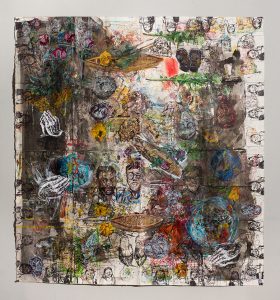
Dark Prayer, 2016
Poet
Eleven years ago, poet Lizzie B. Hutton experienced a seizure for the first time and lost about a month’s worth of memory. She knew that she wanted to write about the experience, but she has found it difficult, in the years since, to properly express her understanding of the event. “The immediate aftermath felt like remembering a dream: I could remember an ephemeral quality, but I also knew I wasn’t grasping it in its specificity,” she explains. “It’s very hard to write about. It’s writing about an absence, a gap. I write around the edges of it, and I try to describe it, but what I’m essentially trying to do is write about something that no longer exists, even in my own mind.
“Because even though I know it happened, and I can name the date when it happened, every time I remember it, I remember it differently. Even though it’s fixed to a date, it’s not fixed in my memory,” she says. “I came to understand how my memory is actually changing minute-by-minute, and my memory of what that experience even was still changes minute by minute. And of course, that moving-target aspect became a real rabbit-hole in my writing.
“I had this project on a laptop, which was then stolen,” she says. “Some was backed up, but some of it was not, and this then became its own metaphor. Literal loss, computer data. That really stalled me on the project. Not just because I’d lost some actual writing, but because I now also wasn’t sure if I could recreate what I’d lost, which was what I had been writing about in the first place.”
She describes how her mind then flooded with an abundance of questions, even as she accepted that there might never be one single, satisfying answer. “How do we experience time or memory? Or, put another way, how do we experience the conviction that we can remember something from the past; what does that conviction feel like in our bodies? Why can we say, I definitely remember this, but this other thing I definitely don’t remember, and what is it physically and mentally that makes that possible? I was still capable of writing,” she says. “If writing is invention, then why couldn’t I just invent what had happened again? I began to wonder, why was the conviction piece, the truthful piece, so vital to the work of writing, as well?
“Once in a while I’ll write a poem that just comes out. It literally comes out from beginning to end, and that’s some sort of weird miracle,” Hutton says. “That’s happened to me maybe three times in my life. The rest of the time—I’m not joking—it takes probably four years for the poem to get finished.”
But she won’t spend every minute of those four years hunched over her keyboard. Time is one of the essential components in her work’s improvement as she revises, draft after draft. “I write out a poem, and think it’s OK, it’s good,” she says. “Or good enough. Then I look at it two weeks later, and I see it’s really not that good. Or, I look at it two weeks later, and parts of it are good, and then I fiddle with it, put the poem down, and then show it to a friend and she might say she doesn’t understand part of it. It’s an iterative process.”
Part of putting the poem down is to pick it up again with new eyes—and a sharper set of responses. “I’m actually trying to subjectively re-experience it,” Hutton says. “With all of my writing, having some distance is a real aid in terms of recognizing that what I’ve written might make total sense to me, because of this weird, crazy network of meaning that’s attached to it in my mind, but it’s not going to be at all apparent to the reader. One-eighth of that might make sense, and seven-eighths might not...but it’s also important to see how that seven-eighths is still valuable and exploratory. So in the act of explicating that last seven-eighths more fully for myself, through the act of revising, I’m also working on the act of communicating with some reader.”
Hutton has found both solace and inspiration in the work of sculptor Eva Hesse, who features prominently in Hutton’s current poetry manuscript. Hutton is as engaged by Hesse’s history—for example, that she escaped from Nazi Germany through Kindertransport—as by her artwork. “Her work is very non-figurative,” Hutton says. “It’s abstract, conceptual art, yet the way she talks about it feels intimately connected with her particular history. Was it a way of coping with her own memory and her past to create this art that feels like a disavowal of the figuratively referential or nostalgic or confessional? She was very much reacting against those approaches—which are these traditionally female approaches to experience—yet I still sense her history in what she makes and does as an artist.
“Another fascinating piece, of course, is that a lot of her work is currently falling apart and degrading because she was using materials that didn’t last,” Hutton says. “She was working with these very organic forms, but she was also drawn to synthetic, man-made materials. Why? Partly, it seems, because it was new. But also, at the time, there was this idea was that the synthetic material was going to outlive all of us. And in some ways, they will. But the materials aren’t entirely permanent, or at least they don’t make permanent art, compared to, say, a marble sculpture in Florence. Some of her work is degrading, changing form, at this astonishing rate.”
She finds a familiar resonance in the situational irony of Hesse’s work falling apart. “I don’t want to attribute intentionality on her part to that,” she says, “but it’s still meaningful. Hesse seemed drawn to the ways that abstract art tries to slip the knot of time. But from an observer’s perspective, now, Hesse’s work seems to be very much about time, and the changes that time makes. It seems to return inevitably to that topic.”
Hutton points out that this erosion also happens in memory. “It’s like going back and finding a journal,” she says, “where you wrote about something very closely that you now no longer remember in the same kind of detail. As time passes, there’s this inevitable cloudiness that covers over the past. There’s a rawness that gets muffled as time goes by. As our remembering continues to chip away at what happened.”
Soft Sculpture by Lizzie B. Hutton ’91
the nicest part of abstraction to me is it’s not about accuracy
that short conversation with whatever’s real in which the real always wins
the made resinous grid answers to a more moving kind of truthful
the shape of the animal waste in the gutter and spring waters running around
the tang of city metal on my hands like well-used places I hold in the subway
the peopledust I pick up with my shoes and imprecise folds in my skirt
I didn’t count among important people in my life any men in my life
I didn’t count among important people in my life they were all dead
they were all dead so by the time I was born it was like I was already dead
in New York the old high-up floors where I worked walls were layered with
thick white paint
drops of the thick stuff melted into the wooden and women-worked factory
floors
enough above trees you could see the sun rising above the old Pan Am
at the end of the street one old high-rise was like a ship’s tilting mast
abstraction draws metaphors to other things only close to their utmost
material forms
the exercise keeps the mind from obsessively wishing it could live forever
I saw snow falling from the hospital bed and how it would melt as it fell
the constant night light of the city snow is what I hate most about this my
city
I hate the country more though for silence when crystallized meanings
appear
there was a night when I was a child when there was no moon in the country
I realized I would die young as I heard the wind move among endless pine
needles
I couldn’t see my own hand there in front of my face though I felt my breath
on it
originally published in the Denver Quarterly, 51.3, 2017
Poet, Critic, Translator
Vincent Katz is a poet, critic, and translator. His work ranges broadly and profoundly across history—collaborating with contemporary artists as well as engaging classical texts and languages. He is the author of the award-winning translation of The Complete Elegies of Sextus Propertius, published by Princeton University Press in 2004, and he is currently at work on a novel based on his time at Oxford University.
“To be a poet, in addition to being a New Yorker, is exciting for me,” says Katz. “I feel as though, ‘This moment is happening right now, and I’m going to write about it.’” Katz is in good creative company. “Frank O’Hara would type poems during cocktail parties. He wrote Lunch Poems on his lunch breaks at MoMA,” he says. “I like the idea that writing poetry can be integrated into all the mess and chaos of daily life.”
This generative process of writing in the moment is natural for Katz and reflects the attentive artfulness with which he observes the world around him. But when he began writing his novel, he found that he had to look to another poet’s writing process for inspiration. “I was reading Andrew Motion’s biography of the poet Philip Larkin, and discovered that Larkin would write for two hours a day,” he says. “He worked as a librarian; he had a nine-to-five job. So he would come home, maybe have a sandwich, write for two hours—and then he’d go out drinking, because that was also an indispensable part of his day.”
Larkin’s two-hour rule appealed to Katz in its routine practicality—allowing the chaos of daily life to manifest after the requisite hours. “I like it because two hours go by quickly, but I also get quite a bit done,” he explains. “I put a two-hour timer on my phone: two hours of writing or reading something directly related to what I’m writing. If I take a break, I can pause it, work down to zero.”
The practice is not merely scrupulous—its structure galvanizes Katz to make real, inspired progress. “If I can get three or four paragraphs of an idea,” he says, “that’s a lot, because that means I’ve generated some energy in a certain direction that I can respond to later. Whereas if I hadn’t done those two hours, I would be nowhere.”
As a formally trained classicist, Katz is adept at uncovering connections across time. “The classics keep reviving themselves. Whatever period I study feels very alive to me,” he says. “I’ve been thinking about Henry VIII for the novel, and that period feels very alive. He kind of reminds me of Donald Trump, although he had more power. ‘Off with their heads’ versus ‘You’re fired.’ Both are highly insecure individuals.”
Bringing historical figures to life in writing is a challenge, but Katz points to recent autobiographies as a guide. “There have been a lot of autobiographies written lately by rock stars from the 1960s and 1970s,” he says. “After reading them, you realize that biography and autobiography are forms of fiction. Even when authors do all the research and have all the letters and the details, they have to recreate some moments through invention.”
In his own novel, Katz found himself compelled by a famous portrait he saw at the British Museum during his time at Oxford University. “This character in the novel goes down to London and goes to the British Museum, where there’s an incredible drawing of Anne Boleyn by Holbein, the court painter for Henry VIII, and it was done in the year in which she was beheaded,” he says. “That gives the drawing a special significance, and it brought me back to a kind of writing I’m very familiar with—writing about art—but in the service of a story.”
Katz was even more intrigued by what was unfamiliar about such a well-known figure. “Anne Boleyn was famously beheaded by Henry VIII. Was she guilty of intrigue? Did she have lovers? Was Henry threatened by her intelligence and independence? Historians don’t know the answers definitively,” he says. “This is a very significant moment in history. Everyone knows her name. Yet, historians can’t agree on exactly why she was killed. I am drawn to moments that have that sense of indefiniteness, because they are lifelike.”
The pleasure he gets from considering that “indefiniteness” shows in his writing, whether as an art critic, a poet, a classicist, or a novelist. “I feel that anybody who’s delved into history or classics feels the same way. The poet Charles Olson was very interested in Mayan culture. Anne Carson, the contemporary poet and classicist, makes Sappho feel very alive in her work,” he says. “But what’s interesting is, we really don’t know anything about their lives. We don’t know much beyond what’s in their written work, so we’re getting a feeling of the person through the literature. It’s exciting that we can have that connection over so much time.”
Now a Trinity parent, Katz was struck by the parallels he sees in his and his son’s educational experiences. “Everything that I liked about Trinity as a student is still here: the passion for learning and the dedication and the seriousness,” he says, marveling. “Oliver has taken four years of Latin here, so to see him reading Catullus and Virgil, and now Horace, remembering doing that myself at his age, has been an extraordinary experience.”
The thought of his son tracing his footsteps makes Katz reach for the metaphysical. “As life goes on,” he muses, “you get the perception that this is going to go on without you, after you’re gone. Some people find that thought to be really daunting.” He’s thoughtful for a moment. “To me, it’s kind of exciting,” he continues. “It’s almost the inverse of my looking back to ancient poetry: These experiences are going to continue for somebody, somewhere.”
Passing Generations by Vincent Katz ’78
I seem to be in some random place,
Like much of America: malls, shops,
Pizza joints, but this is not random,
Is our place, molded, fashioned, of love.
Those difficulties keep cropping up,
I can’t keep track of things,
Nor does poetry seem valid enterprise.
That does not, however, diminish
The over-riding goal. Twenty one years ago
On this date, I wrote a poem about the
Moving of things in and out of a life.
Now I try to see behind the things we
Worry about, to transfer passions from
Generation to generation, respect for things.
People are not often aware what
Goes on behind, or underneath.
originally published in Odes,
Vincent Katz & Alex Katz,
Bernard Chauveau Editions, 2015

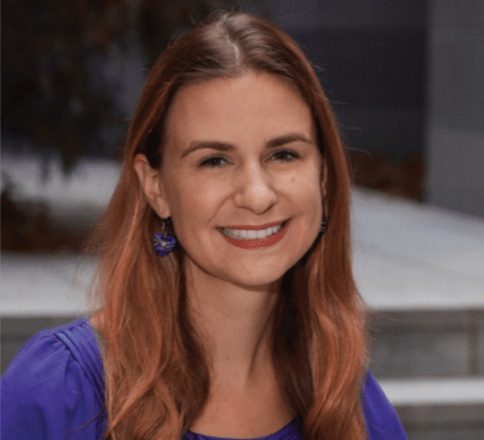
Last Word – Janine Cuervo
Last Word
A Middle School Teacher of Mathematics Considers Time
By Janine Cuervo
Favorite Math Concept: Golden Ratio
Favorite Poem: "Desiderata” by Max Ehrmann
Favorite Book: The Four Agreements by Don Miguel Ruiz
Favorite Hobby: Yoga
Favorite Sport: Tennis
Favorite Sports Team: Green Bay Packers
Every summer as the school year inches closer, I reflect on my time spent at Trinity and think about the time I will spend teaching in the upcoming year. I embrace the combined feelings of enthusiasm and anxiety as I begin to think about the number of things I must prepare before the first day of school. I feel the constant pressure of time, wishing for more hours in the day, every day. Many of us feel the same limitations of time in some context, whether you’re a fellow colleague, parent, or even student. With the busyness of our day-to-day life, time can often present itself as a constraint, but this year I will try to look at it with new eyes and view time as an opportunity.
The truth is, there are many components of time in a teacher’s life, in addition to teaching. These responsibilities and classroom interruptions sometimes encroach on the time we have with our students or time to plan and reflect on our lessons. However, instead of perseverating on lost time that we cannot always control, I have begun to think of the opportunities that time does allow. This year I choose to see time as an opportunity within three core areas of my teaching practice: future planning, present teaching, and past reflection.
Planning lessons with my math colleagues is representative of the future time I will spend with my students. We set aside time to plan together and discuss how our students engage and grasp the material. Designing each lesson with a variety of learning experiences helps us focus on the learning objective, student engagement, enriching questions, and ways to assess understanding. We will continue to maximize our planning time together because we cherish building on each other’s ideas to create the best learning opportunities for our students.
Present teaching is the time I spend with my students daily—the classroom is my stage, and each day is a new beginning, with both predictable and unpredictable opportunities for learning and growth. Teachable moments—where students share their own experiences with math by exploring topics and engaging in conversation—represent the most valuable time we spend together. When they occur, I face a choice: to pursue the conversation or to move ahead with the curriculum. In previous years, my mindset would repeat, “There’s not enough time! I must teach the quadratic formula so they know it in ninth grade! I need more time!” But this year, I want to truly embrace these moments of unexpected learning and focus on the time that I do have with my students.
Everyone needs time for reflection to improve. Over the summer I use time to reflect on my work in the previous year and to refine previous lessons. I am thankful that Trinity provides me with the opportunity to engage in grant work so that I can review what has gone well, make improvements on my curriculum, and collaborate creatively with my colleagues. This additional time for reflection helps me learn, grow, and offer a fresh, more meaningful perspective moving forward. How can we find more opportunities for reflection to inspire our future?
Moving forward with this new mindset I will not let the constraint of time control how I plan, reflect, and especially teach. After all, being with my students, seeing their “light bulb” moments, learning from them, laughing with them, and crying with them, is the heart of my career, my passion, and my life. I challenge you to also choose to unlock the opportunity of time in your life, career, hobbies, time spent with family (and friends), or reflection.


Classroom Comment – Sonia Kanwar ’26
Classroom Comment
A Grade Five Student Writes About Her Experience of Time
By Sonia Kanwar ’26
Favorite Movie: The Sound of Music
Favorite Food: Sushi
Favorite Books: The Harry Potter Series
Favorite Holiday: Valentine's Day
Favorite TV Show: The Loud House
Favorite Sport: Squash
Favorite Author: Enid Blyton
Favorite Place: The beach
Life is all about time.
I used last summer to think about what time means to me.
Even when times seem difficult they are usually meaningful. Last summer I moved to a new neighborhood. It was hard for me. I didn’t want to leave the apartment where I lived for the last seven years. I have some really special memories in my old neighborhood where I learned to ride my bike, sled in the park across the street, and begged my mom to get me ices. But I have a lot to look forward to in my new neighborhood—playdates with my friends who live close by, being closer to Central Park, Chelsea Piers, 16 Handles (which is in my new building), and also Trinity. Now I’m looking forward to being able to sleep for five whole minutes more, which is just another way to think about time.
Another thing I realized was that time can pass differently depending on what you like and what you don’t like. Waiting for my brother’s choice on the TV feels like a million years, while on the other hand, me watching TV alone seems to pass in two minutes. Waiting for my dad’s cheeseburgers on the grill seems to take a lot longer than it takes to devour one. I love ceramics, so making pots shaped like my dog, Murphy, takes no time at all.
I also realize that long periods of time—such as school years—can also seem to pass by very quickly. Kindergarten seemed to go by the quickest, maybe because it was my first year at Trinity. Now it’s a little surprising to me that I’m already in fifth grade.
We all have special moments in time that seem to stand out. Looking back at my five years at Trinity, some of those include the Halloween parade in first grade, the Harlem Renaissance in third grade, and the South Asian Chapel that I participated in. One of my favorite times was researching the borough project in social studies where I got to take my family through Brooklyn, to a great part called DUMBO (Down Under the Manhattan Bridge Overpass). We also went to a cool museum, Prospect Park, and ended the day with Brooklyn famous pizza.
Friends can make time feel more special, such as this summer when I spent time with friends in the pool and took surf lessons. We walked to get ice cream at my favorite ice cream place. Going to the beach, playing sports, doing craft activities, playing board games and puzzles, and having water fights all seem so special when you get to do them with friends.
But it doesn’t all need to be full of activities. Some of my favorites times are doing nothing, or simply reading, staring into space, or maybe annoying my little brother just a tad. (Shhhhhhhhh! Don’t tell anyone. I don’t want to be grounded for life!)
Sometimes we spend more time worrying about something than it deserves. For example, I spent a lot of time worrying about falling off the surfboard if I stood up. Finally, I just decided to pop up and I fell down, but I realized it really wasn’t worth spending time worrying about. Then I got to ride the waves a few times and realized it was really a lot of fun.
Time also teaches you the importance of making good choices. It takes a lot less time to make a mistake than it does to fix it. And that time spent fixing can teach you how to make a better choice the next time around. I learned this the hard way when I spilled a container full of watermelon all over the floor even though I was told not to play with it. It took a whole twenty minutes for me to clean it up. I’m not doing that again.
Another way time can go by slower is if I’m really hungry and just ordered food at a restaurant. It can feel like hours before it finally gets to the table.
At the end of the summer, I made some goals for how I want to spend my time. I decided I want to spend it making memories with friends, working hard, learning new things, and most importantly, having fun.
I hope now you see how important time is!

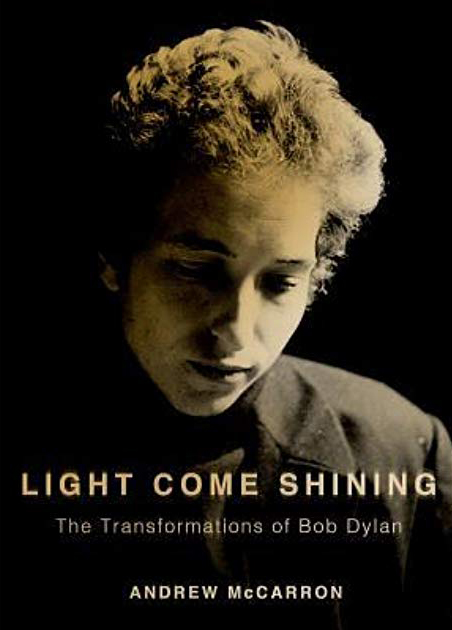
Author Profile – Andrew McCarron, Head of Religion, Ph...
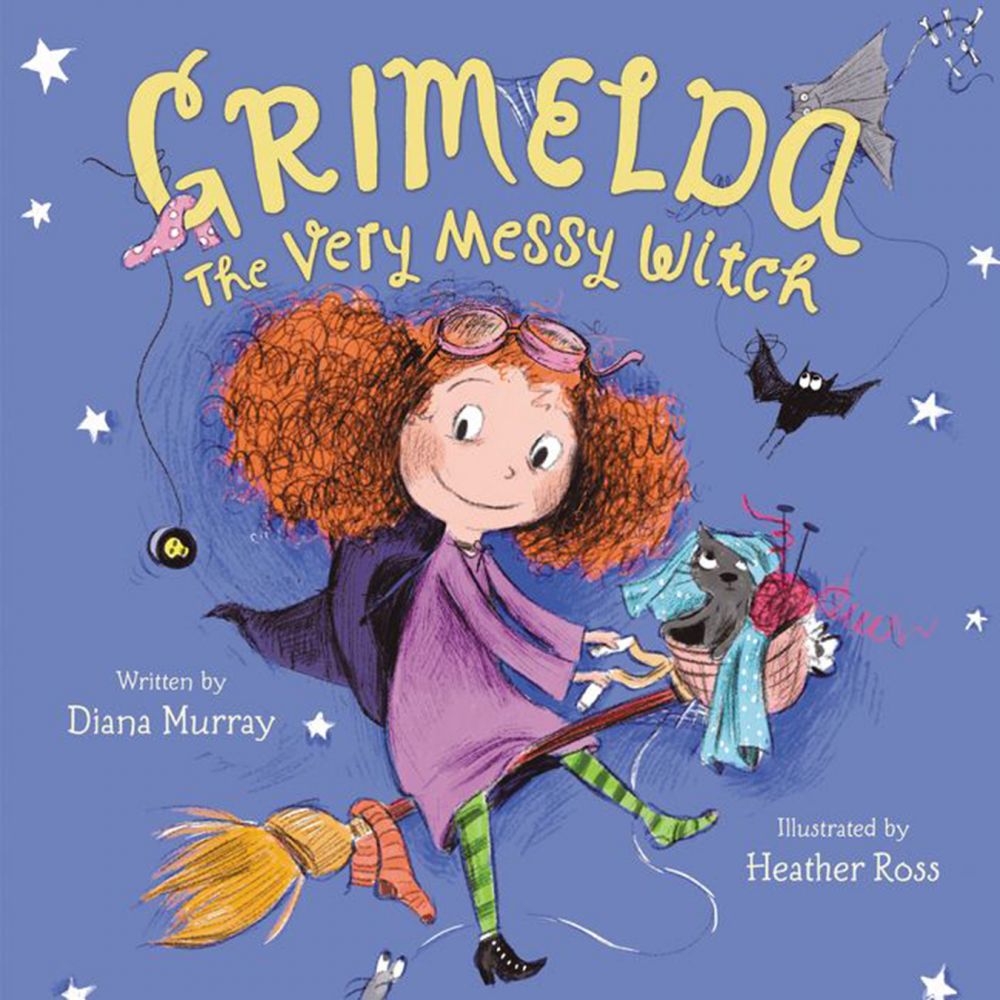
Author Profile – Diana Murray ’90
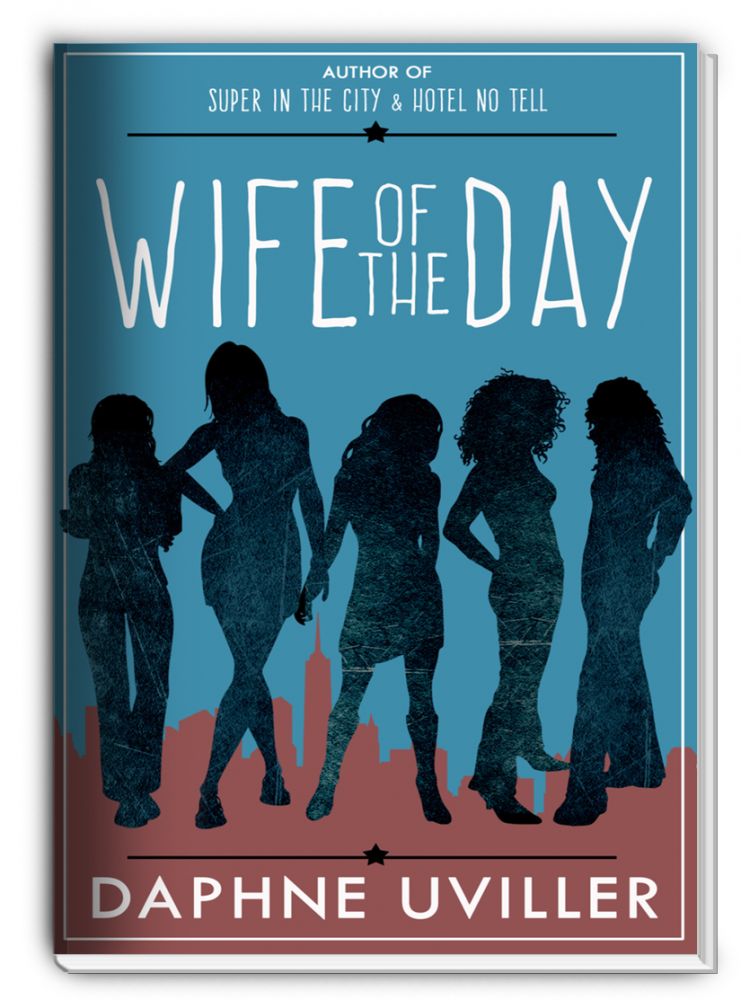
Author Profile – Daphne Uviller ’89
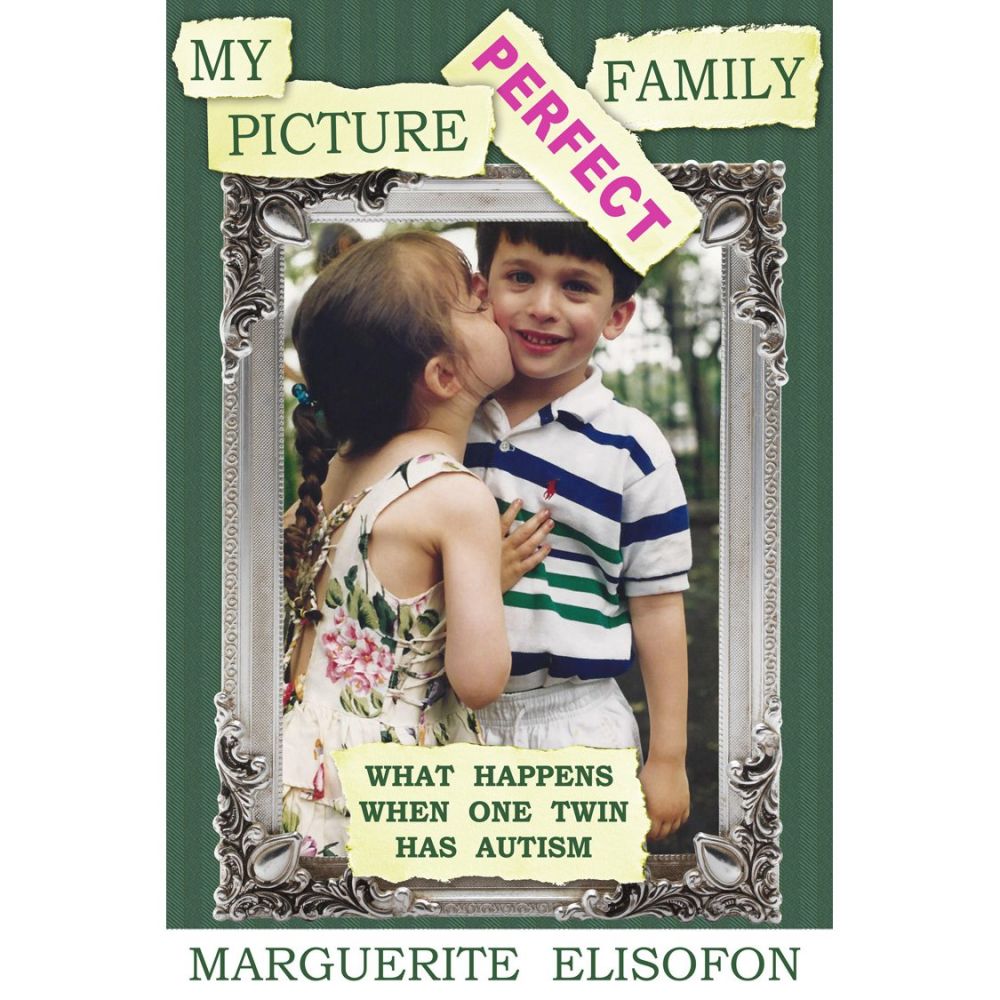
Author Profile – Marguerite F. Elisofon ’74
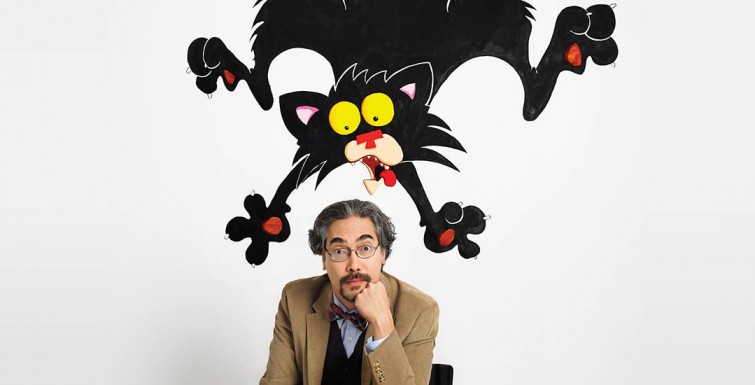
Nick Bruel ’83 – Author Profile

Catherine E. Price ’97
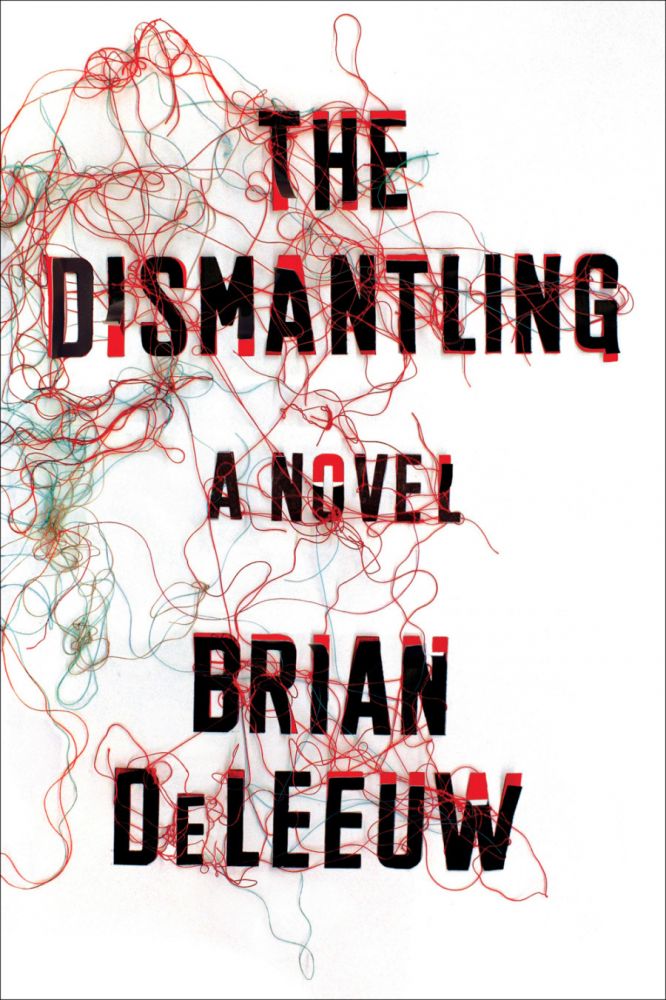
Brian DeLeeuw ’99
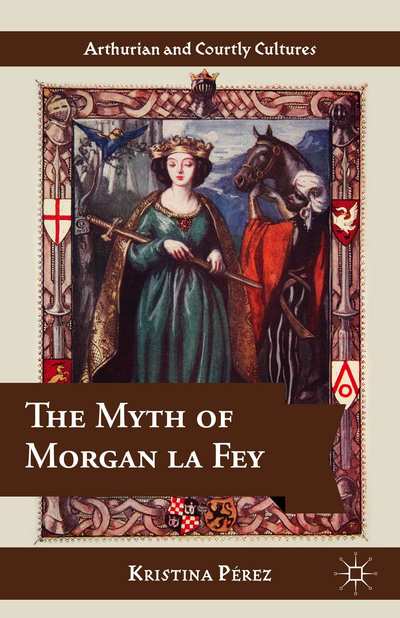
Kristina Pérez ’98
Kristina Pérez ’98, talks about her book, The Myth of Morgan la Fey and discusses the changing roles and interpretations of one of the most powerful and enduring female characters in English literature. Her book is reviewed in the summer 2015 edition of Trinity Per Saecula.
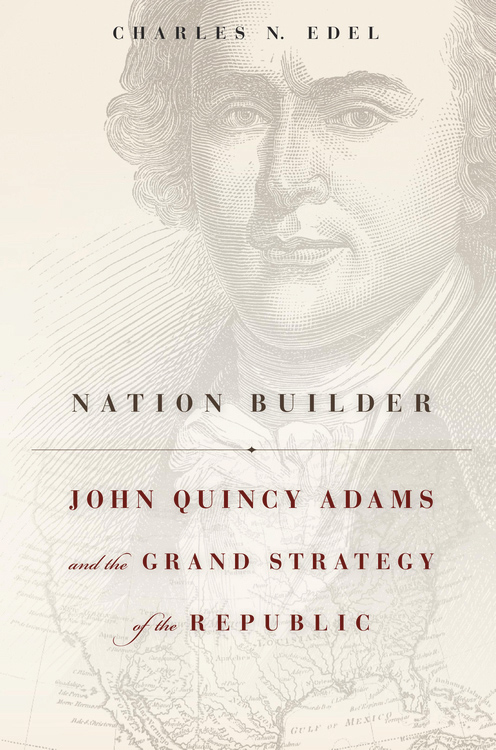
Charles Edel ’97
Charles Edel ’97, talks about his book, Nation Builder:John Quincy Adams and the Grand Strategy of the Republic and the importance and relevance, in today’s world, of the sixth president of the United States. His book is reviewed in the summer 2015 edition of Trinity Per Saecula.
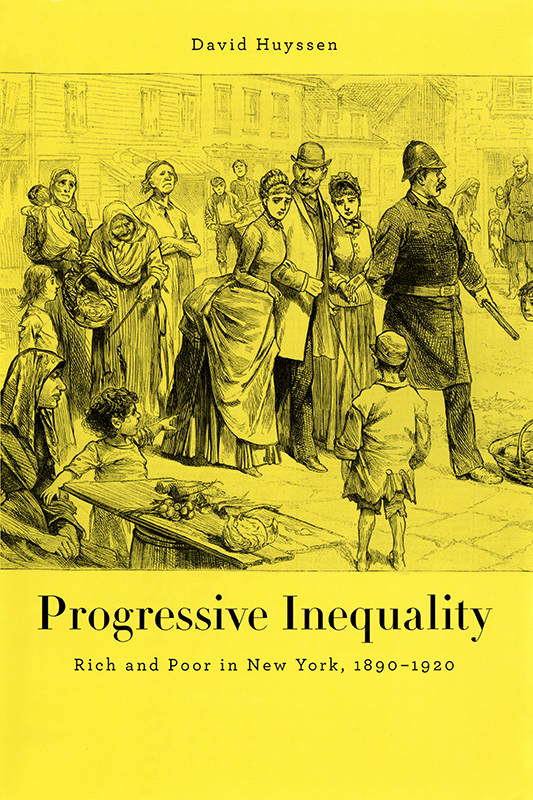
David Huyssen ’98
Trinity Fund Supporter since 2004